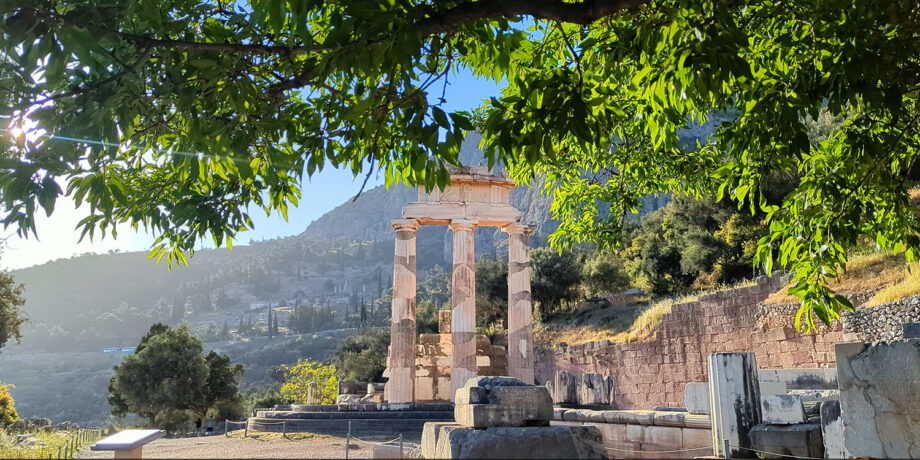
The cult center of Delphi: its history, architecture, oracles, Greek myths & art
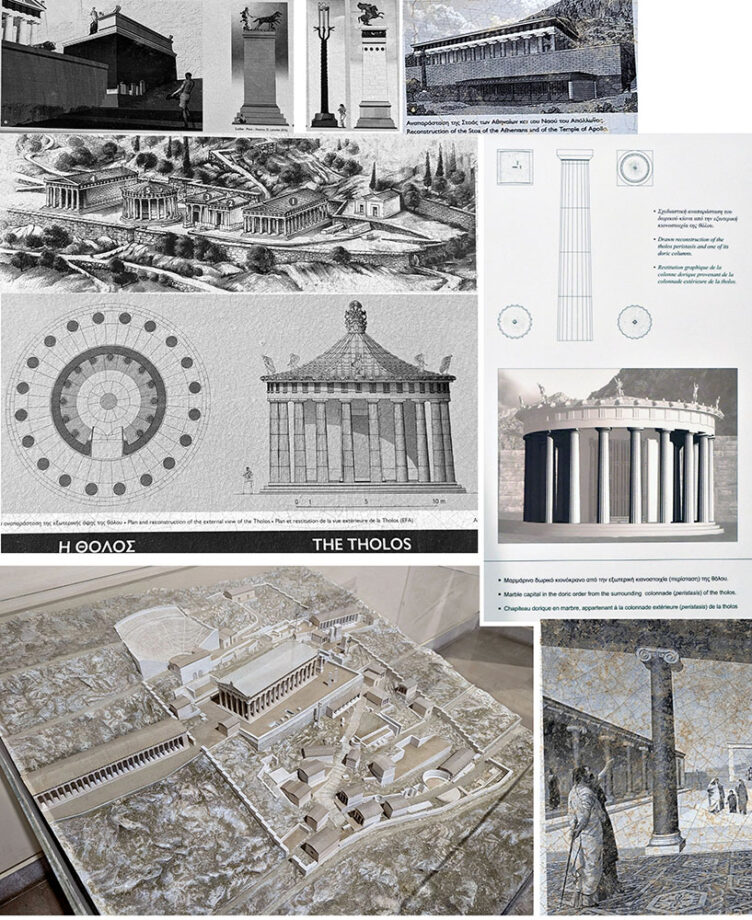
When I looked at the images of Delphi before going to Greece, I wasn’t impressed with the site. Not much was left there but a few columns and stones. However, when I reached that place, I was stunned by Delphi’s ethereal beauty and historical significance. The ruins of ancient Delphi lie less than a mile east of the modern town of Delphi (which is small and insignificant).
Situated at the top of Mount Parnassos, the breathtaking view of ancient Delphi channels mysticism, history and unique culture. This is the place where Zeus marked the center of the world, God Apollo slayed the serpent, the oracle uttered her prophecies that influenced ancient Greek history, the Pythian Games came about and the Greeks worshiped their gods with incredible offerings. Delphi couldn’t be a more beautiful place for a temple to Apollo.
According to ancient legends, the first settlement of Delphi was a shrine of the Earth Mother, Gaia. Ice-age people worshiped her divine powers. When the Mycenaeans lived in the village, Delphi was already known for its sacred oracle and prophecies around the second millennium B.C. (according to the International Dictionary of Historic Places, book).
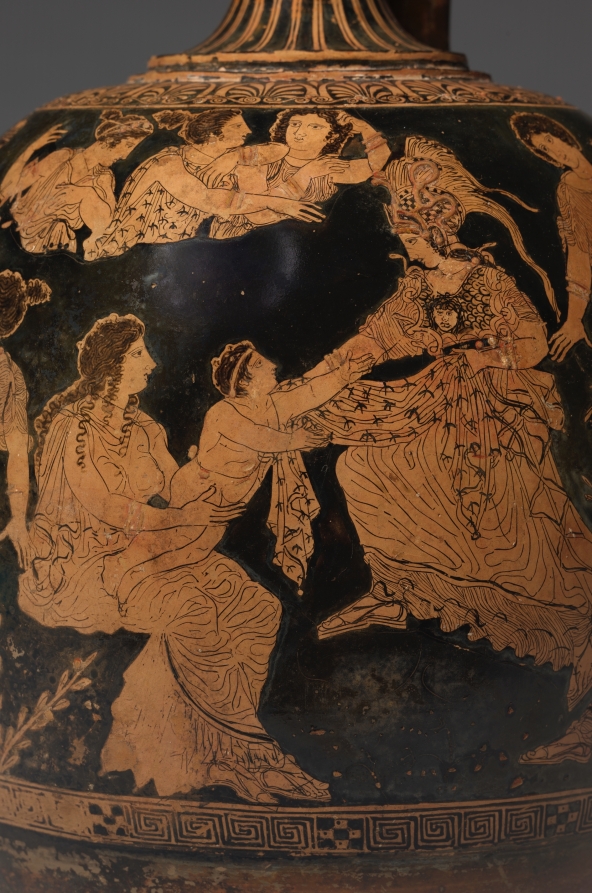
The seated earth goddess Gaia or Ge handed her baby, Erichthonios, to Athena. Conceived from the seed of Hephaistos, Erichthonios would go on to become a king of Athens, and the story of his birth became popular in Athenian art of the 5th century BC.
In antiquity, reaching an important cultural cult center and sanctuary of Delphi would be a long and tough journey traveling from Attica or other places. It would be a place of cleansing, worship, and rich offerings to receive guidance from the oracle. The messengers sent to enquire of the oracle entered the sanctuary only after being purified in the Castilian Spring. The ancient Greeks consulted the Delphic Oracle as she spoke the truth channeling prophecies from God Apollo himself.
When you reach Delphi, you’ll see the ruins and foundations of both temples and votive offerings in the Sacred Way with some reconstruction and artifacts in the archeological museum. The sanctuary was destroyed after the last Roman Emperor, Theodosius I, in the name of Christianity, wiped out the temple of Apollo and art in the sanctuary around 390 AD. Only in the 17th century, considerable interest emerged with major excavations taking shape in the 19th century. Greece became independent from the Turks in 1829, and archaeologists began researching the site. They removed a small village built atop Delphi and unearthed the ancient ruins in the late 19th century. In 1935, archeologists found a pit below the paving of the Sacred Way filled with precious materials that got destroyed in the earthquake of 548 B.C. They included parts of the chryselephantine statues (female heads made in bronze and gold), miniatures, silver bull fragments, and other artifacts now displayed at the Museum of Delphi. You can also see some pretty amazing archeological finds like the Naxian Sphinx and the bronze charioteer.
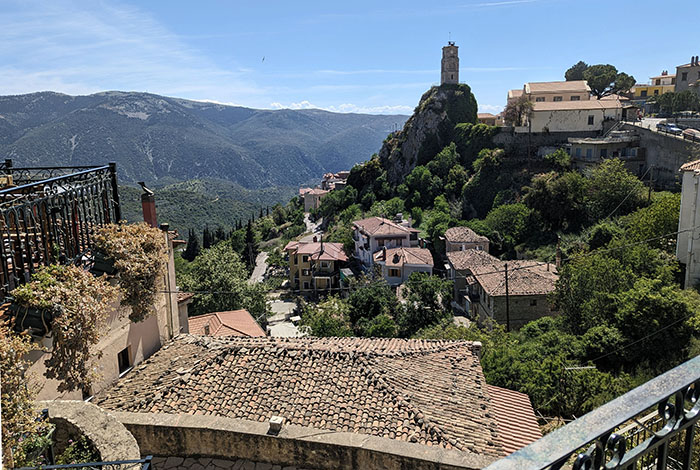
On your way to Delphi, stop by a small and beautiful town, Arachova. Have some coffee there and climb up the stairs to see a local church. You’ll find a perfect spot for selfies with a stunning landscape below.
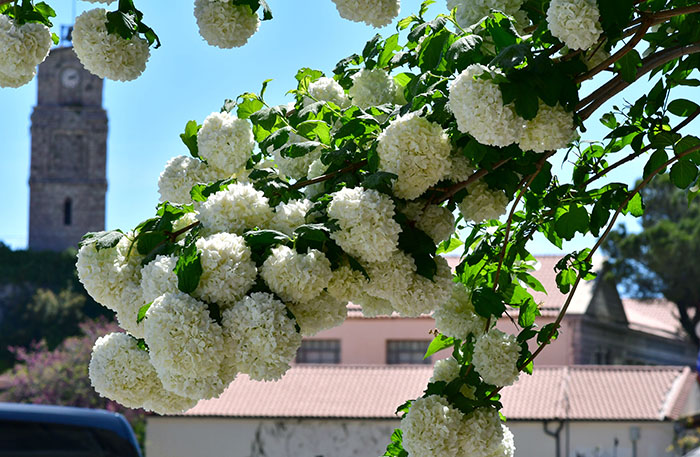
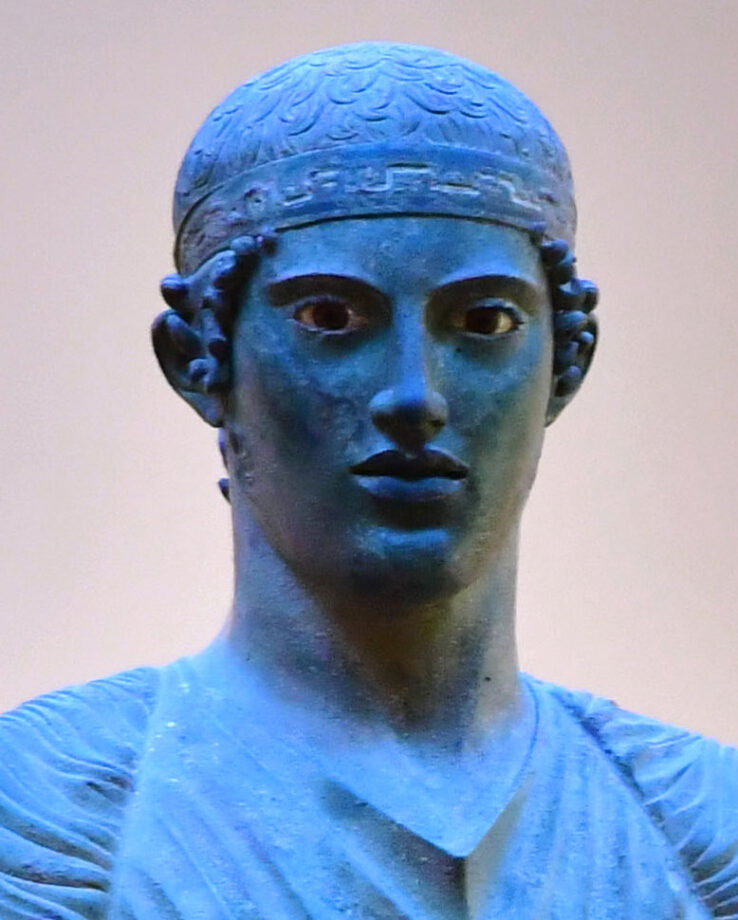
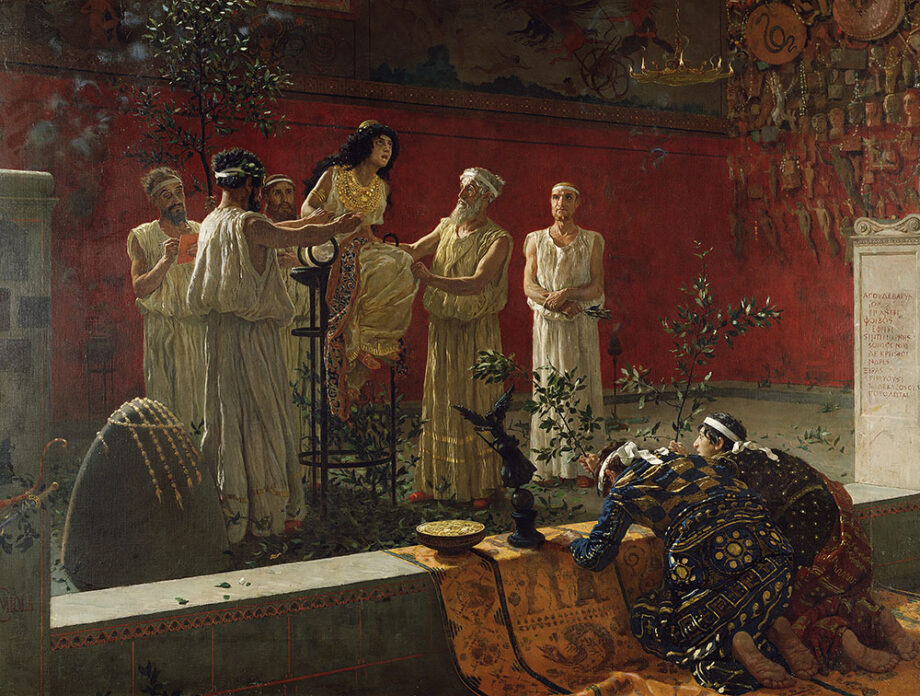
The Tholos of Delphi
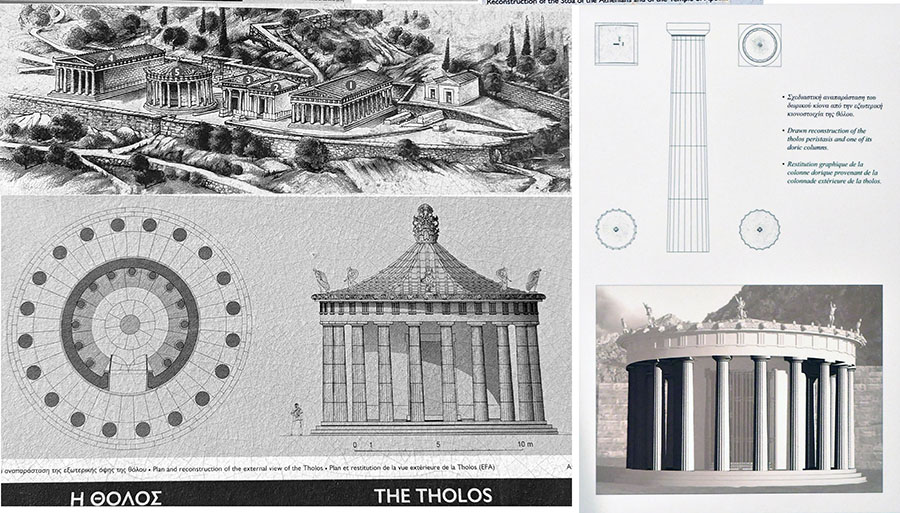
One of the most interesting ancient Greek buildings is the Tholos of Delphi. It’s a masterpiece of ancient Greek architecture because of its elaborate decoration, polychromies, and exceptional craftsmanship. In antiquity, the Tholos stood out among the monuments of the Sanctuary of Athena Pronaia, the first sanctuary encountered by the pilgrims arriving from Attica or Boeotia.
In the early 4th century BC, the circular edifice consisted of a core structure built from the Pentelic marble originating from Mount Penteli in Attica. Theodoros from Phocaea was the architect of this building because the Roman architect- Vitruvius mentioned his name in the book titled “De Architectura.” The floor was made of white marble in the center and dark limestone from Eleusis towards the circumference.
The marble roof had layered square panels and bows. The outside space had decorations of dancing women, clay tiles, or marble slabs.
Made of twenty Doric columns, the outer colonnade supported a frieze with triglyphs and metopes. What we see today at the site is just three columns that were restored in the 1930s to give us a better visual reference of the building. You can see the smaller interior metopes of the tholos in the nearby museum. These are broken pieces of figures from Greek mythology and history.
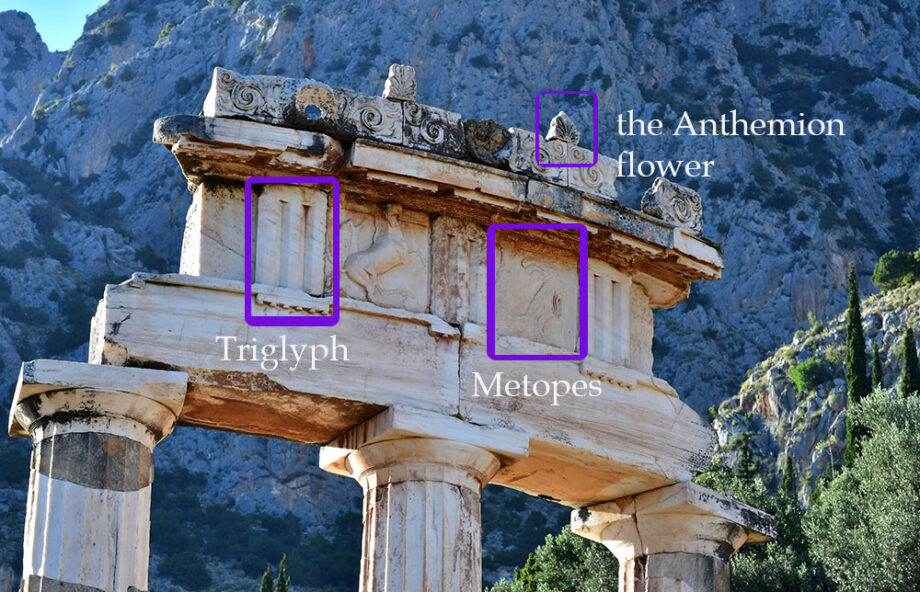
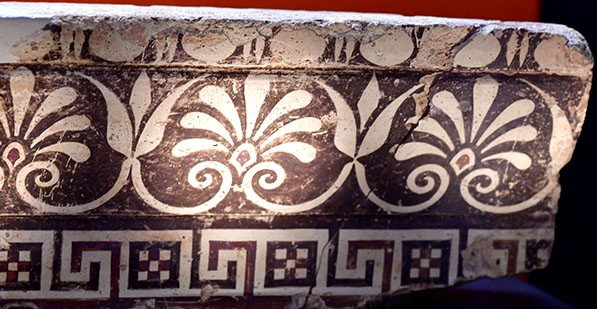
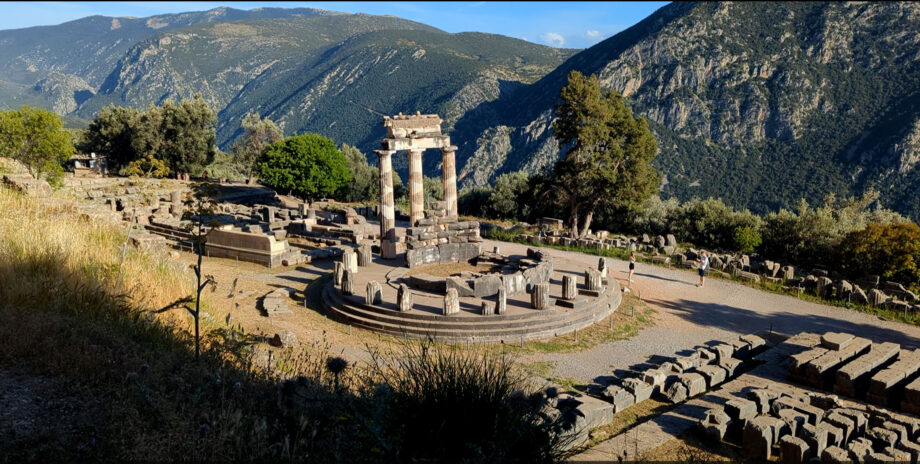
The cella or ‘temple’ is the inner, windowless chamber with a door in ancient Greek buildings. It usually contained a cult statue or a table with precious offerings. In the Tholos of Delphi, the inner colonnade of ten Corinthian-style half-columns decorated the circular wall inside the cella. The relief metopes of the outer frieze had the scenes of Centauromachy and Amazonomachy, now on display in the Archaeological Museum of Delphi. The conical roof also had sculptural decorations. The original function of the building is unknown. It was possibly associated with the cult of Mother Earth, the first divinity worshipped in the sanctuary.
The open area of circular Halos, which means the “threshing floor” used to have religious significance with a ritual held every eight years in that place. The ritual showed a reenactment of the god Apollo slaying the serpent. The boy who impersonated Apollo walked the Doloneia staircase situated at the rear of the Halos. There were 4 semi-circular exedras built surrounding the Halos in antiquity with just two of them preserved today. Exedra means a portico or arcade with a bench or seats for people to converse.
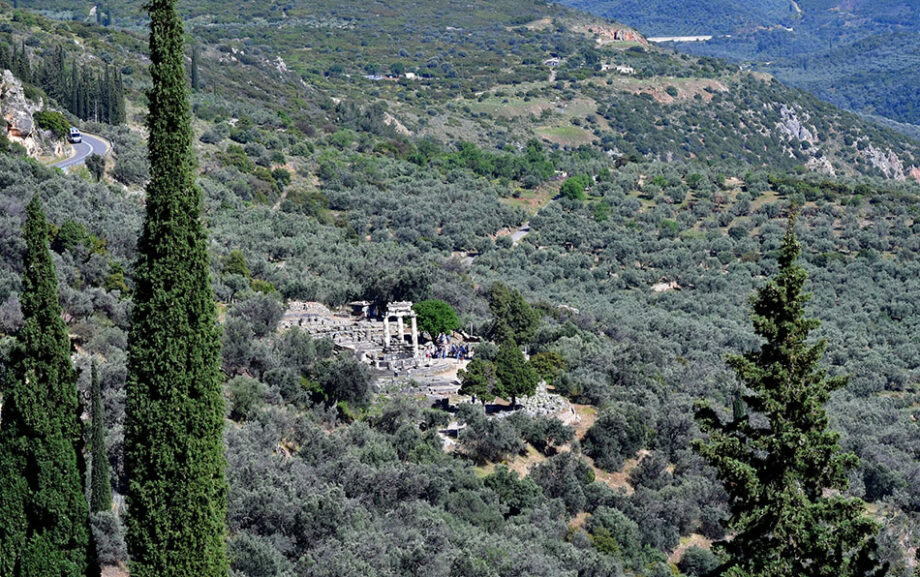
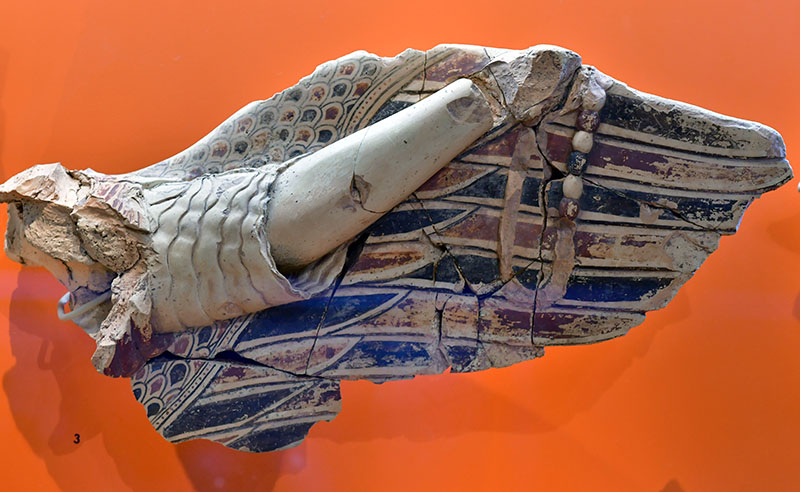
“Polychromy” means “many colors” in Greek. There are traces of colors left on some ancient Greek sculptures showing cinnabar red, yellow ochre, carbon-based black, and blue pigments.
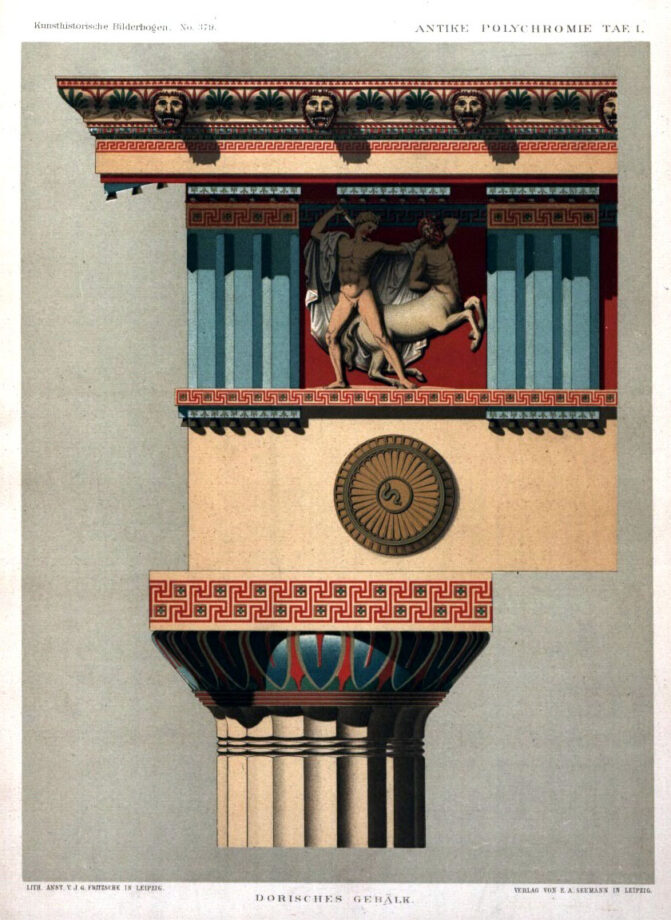
This is a reconstruction of the Polychrome decoration characteristic of the ancient Greek architectural style.
The Omphalos of Delphi
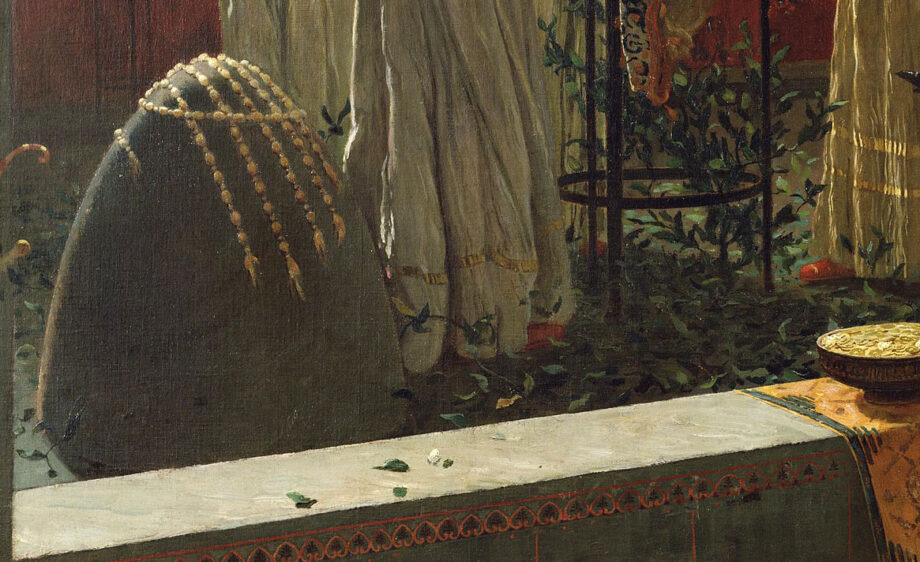
The Rock of Sibyl: The oldest cult center in Delphi was made of rocks fallen from the Phaedriades, dark limestone cliffs on Mount Parnassos. According to a local tradition, the first prophetess of Delphi, the Sibyl Hierophile, stood here to utter her oracles. It’s believed she had foreseen the fall of Troy. The ancient sanctuary of Earth (Ge) appeared around the sacred spring in this area, meaning that Delphi was the center of the world.
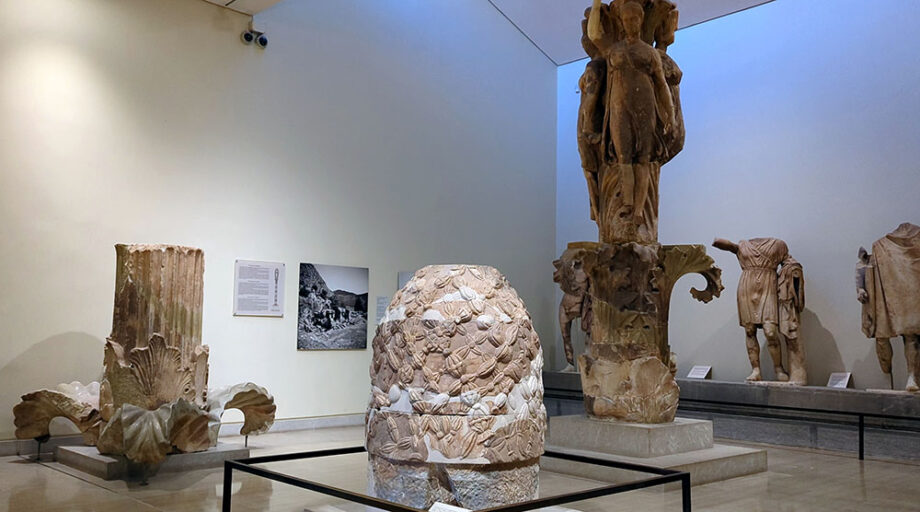
The sacred omphalos of Delphi (or navel-stone), are believed to have fallen from the heavens. Devoid of artistic shape, it was a conical stone thrown down by Zeus to find the center of the world, the Earth’s navel. According to the Greek myth, Zeus released two golden eagles to fly in opposite directions from Mount Olympus. These two birds met over Delphi and Zeus threw down a stone there, which became the Earth’s navel thereafter.
This marble representation of the omphalos is a Hellenistic or Roman copy of the Archaic omphalos, which was kept in the adyton inside the temple of Apollo. The adyton was a restricted area within the cella of a Greek or Roman temple. It was the most sacred part of the temple, often located at the end of the cella, and translates to “innermost sanctuary, shrine” or “not to be entered”. The ancient writings suggest that the sacred tripod, prophetic laurel, and omphalos were all kept in the adyton of the Temple of Apollo, where Pythia pronounced her oracles.
The relief decoration of the stone imitates the weave of the agrenon, the thick woolen net with attached bands of wool that covered the original sacred omphalos stored inside the adyton. There were many copies of the sacred omphalos that existed at the sanctuary. The exhibited stone may have been the one witnessed by the travel writer Pausanias in the 2nd century AD. According to him, the tied bands had points with gorgon-shaped precious stones. The two golden eagles were affixed to its top.
It's quite fascinating to learn that the omphalos played an important role in the oracle's predictions, suggesting that Pythia talked to Gods and channeled her oracles through this stone. Moreover, it's speculated that Apollo buried the Python (that was the Earth's spirit) under the Omphalos and that allowed for this communication.
The Delphic Tripod: Apollo, Hercules & Pythia
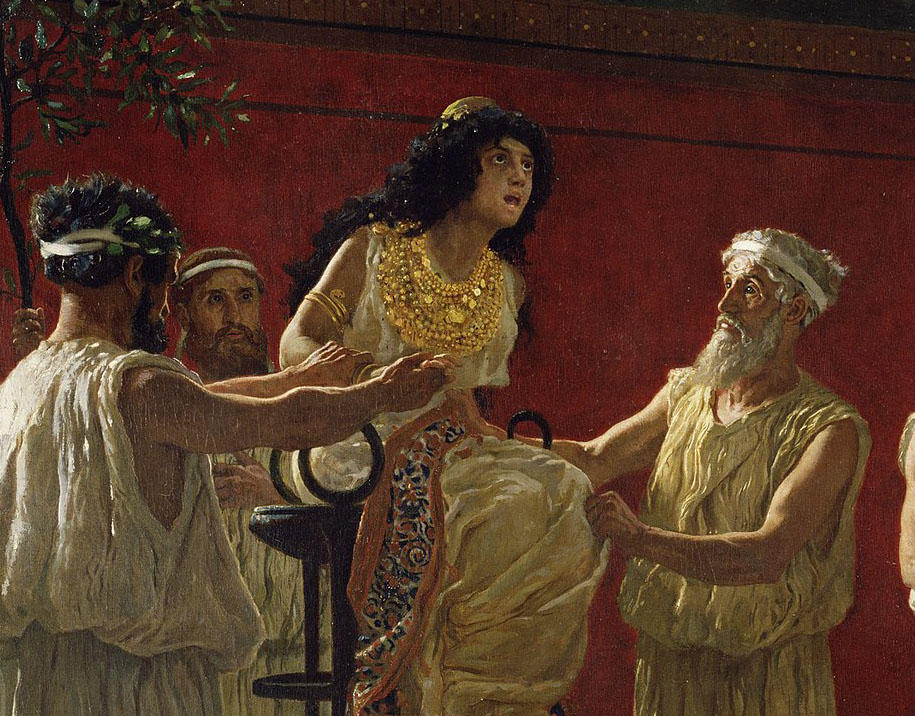
Painting detail showing the Oracle of Delphi sitting on the Delphic Tripod uttering the prophesies. This Delphic tripod was a chair on which the oracle sat.
Apollo as the oracular god, Dionysus as his brother
The Greek god Apollo arrived at Delphi around 1000 B.C. In legends and myths, the oracle of the earth goddess, Gaia was guarded by a great serpent, the python. Apollo killed the serpent with an arrow and became known as the Pythian Apollo. Apollo is the most important oracular god in ancient Greece. He helped ancient Greeks navigate decision-making by knowing the future and communicating the thoughts of his father, Zeus. Therefore, the oracle was so important to the nation, giving people the divine guidance they needed to live their lives.
So consultations with the oracle took place in the temple of Apollo every month. The rituals happened inside the temple’s adyton. A priestess sat upon a tripod to cry out her oracles. Following a purification ritual at the Castalian spring, she was believed to be in a trance answering questions from the visitors. Some important outcries were engraved on stone. Those cries received interpretation from priests and were written down into verses. People asked different questions in regards to their personal lives, and military and religious conquests. The city-states also asked questions that were written down on a sealed tablet to travel back to them. According to the museum’s description, 615 prophecies were saved in literary sources and inscriptions. The interpretation of such prophecies or oracles was ambiguous because the person who asked the question could interpret them as well. Therefore, God Apollo was also known as Loxias or ambiguous. He represented the best virtues, mainly art, music, poetry, beauty, health, and reasonable behavior.
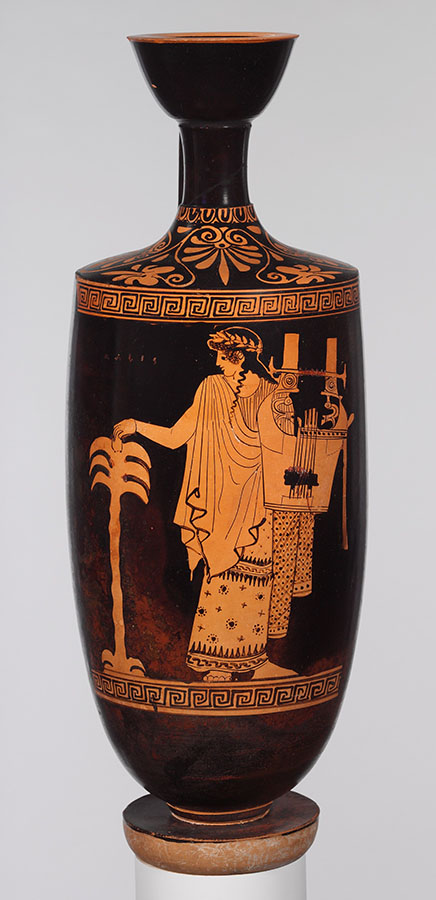
Apollo’s younger brother Dionysus, was also worshiped at Delphi. In ancient Greco-Roman sculpture, Dionysus has a beautiful slender body and long, wavy hair, and sometimes is thought to be Apollo and vice versa. Dionysus was the god of wine and irrational behavior. The two gods were worshiped at different times of the year.
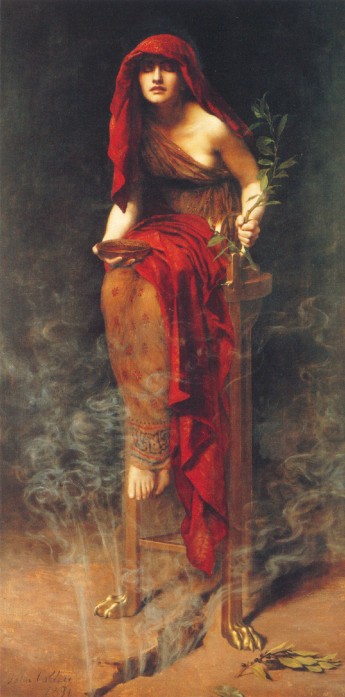
John Collier, Priestess of Delphi, 1891, oil on canvas, 160 cm (62.9 in); width: 80 cm (31.4 in), Art Gallery of South Australia. The artist imagines Pythia sitting on a tripod with vapor rising from a crack in the earth beneath her.
Several known inscriptions came from the Delphic oracle. In 680 B.C., an oracle ordered the citizens of Megara to find the city of Byzantium (Constantinople/ İstanbul). In 547 B.C., Croesus, the king of Lydia, was told that he would destroy a great kingdom if he crossed the Halys River. He did so, was defeated by the Persians, and it was his own kingdom that was destroyed. In 480 B.C., Athens was threatened by Persian military forces. The oracle told the Athenians that they would be unconquerable behind a wooden rampart. This prophecy proved to be true: an Athenian fleet composed of wooden boats defeated the Persians at the decisive battle of Salamis. Many other of the oracle’s pronouncements influenced political and economic decisions of importance in the Mediterranean world. In return for the oracle’s advice, the temple received numerous valuable gifts. The remains of some of these treasures can be seen in the Delphi Museum. (International Dictionary of Historic Places).
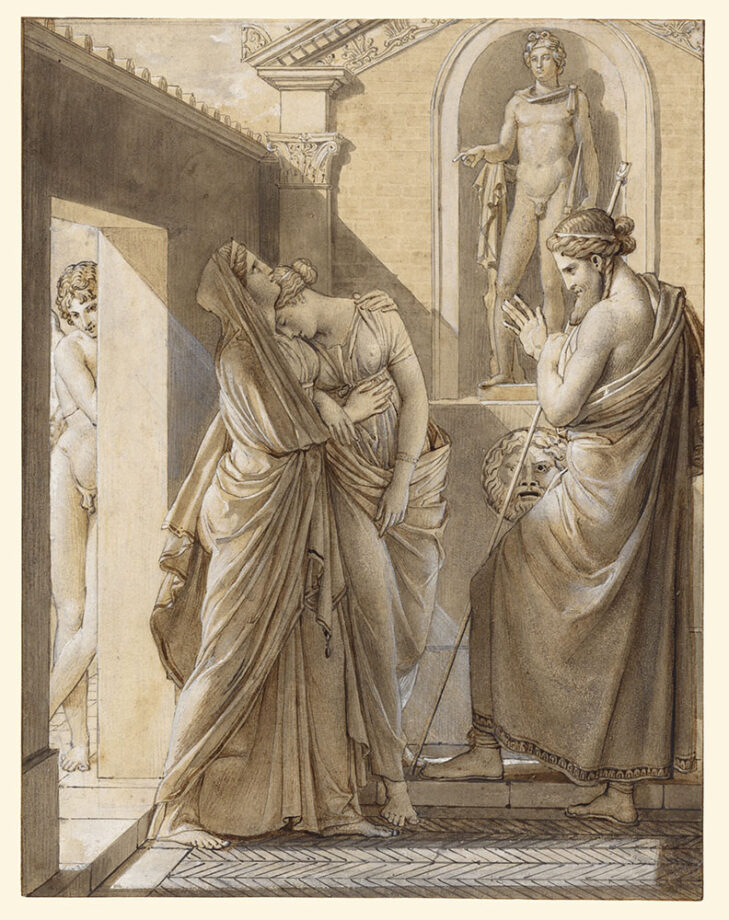
In the picture, Psyche and her mother enter the temple of Apollo at the moment when the oracle delivers a message from the god. With his pointed finger, Apollo prophesies that beautiful Psyche will marry a monster. While the girl falls into despair in her mom’s arms, her father and Cupid stay calm, suggesting reason over emotion.
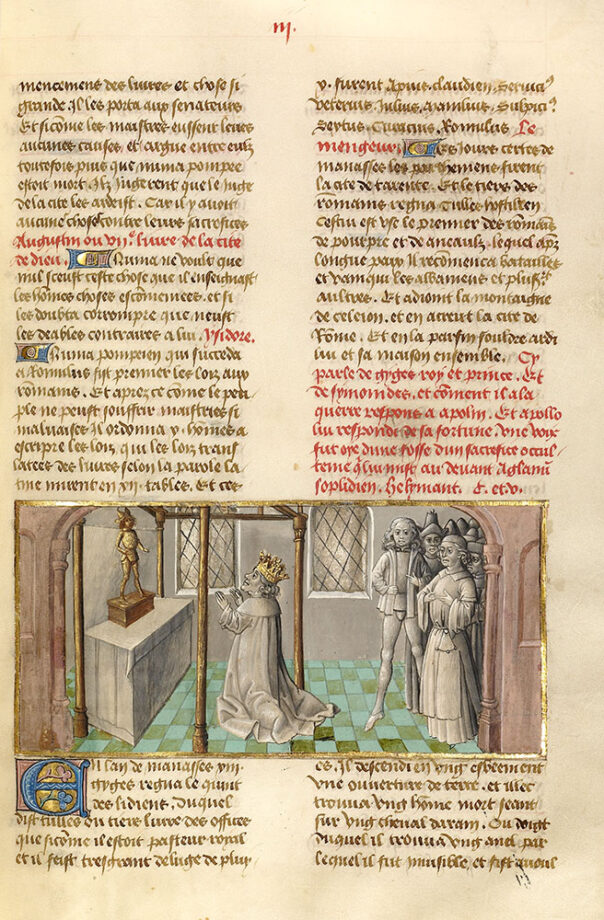
This is one of the pages from the illuminated manuscript depicting the Oracle of Apollo.
Apollo slaying the serpent Python in Greek mythology
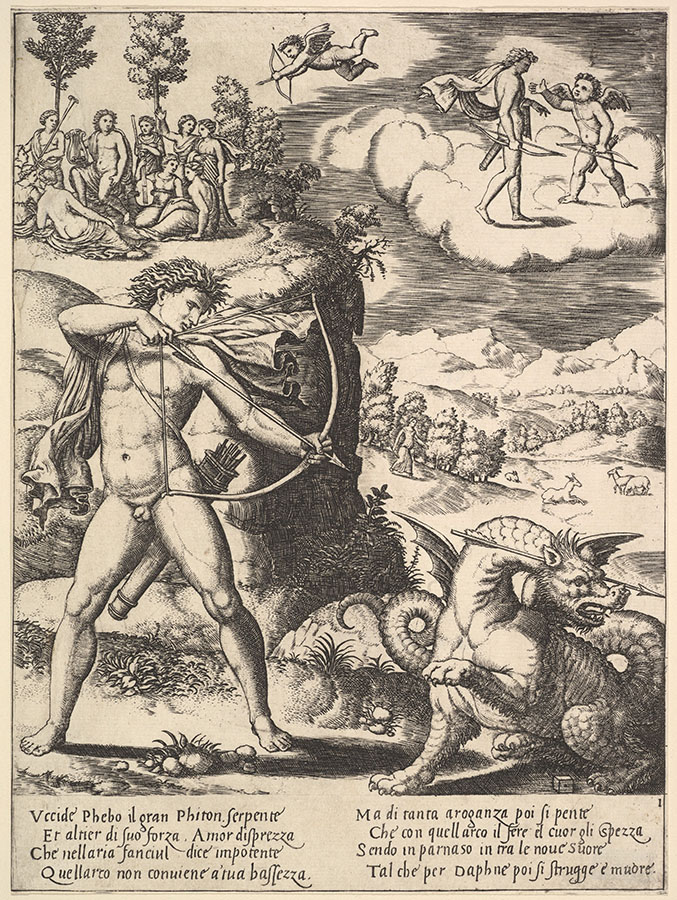
In Greek mythology, Apollo was the son of the king of all gods, Zeus (Jupiter) and a Titan mother, Leto, goddess of darkness. Apollo was one of the twelve gods of Olympus. Python was a gigantic serpent, the son of Gaea (the Earth goddess and the first goddess of the sanctuary), that lived inside the Earth in Delphi in accordance with the ancient Greeks belief. Hera, the wife of Zeus, got upset and decreed to kill Leto before giving birth to her child. Eventually, Leto gave birth to twins in a cave, Apollo and Artemis (Diana), the god of light and the sun and the goddess of the moon and the hunt. Hera sent the python to kill them but baby Apollo protected his family and slayed the serpent shooting arrows with his bow. Apollo's punishment for that act was his servitude to King Admetus as a cowherd for 9 years.
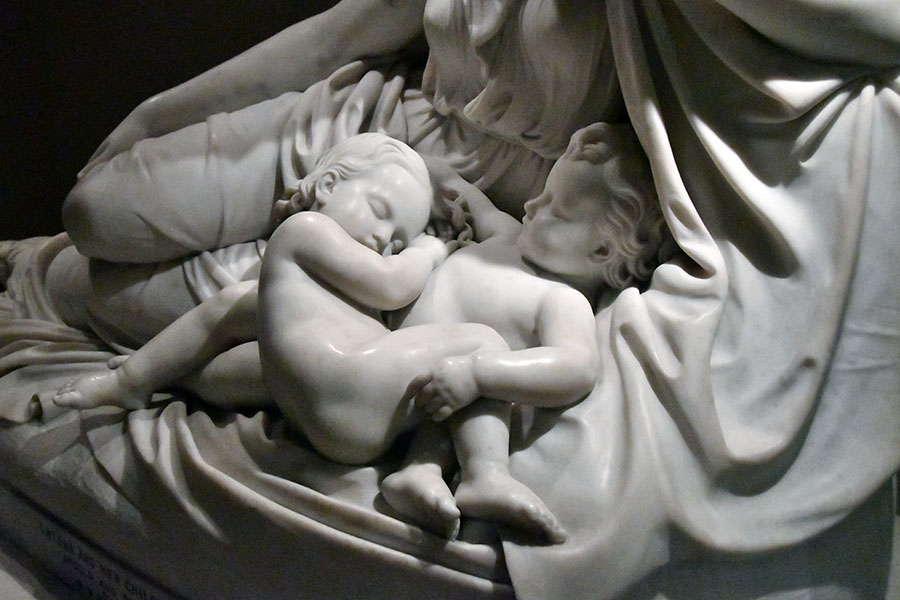
In classical, Greco-Roman sculpture Apollo is the ideal of male physical beauty. He was shown nude with arrows and a bow, young, tall, fit, beardless, with long wavy hair collected in a bow-like not and beautiful, well-proportioned face. There are many depictions of Apollo in art history. I think the most beautiful ones are the "Belvedere Apollo" in the Vatican and Bernini's "Apollo and Daphne" in Rome. Below you'll find the most beautiful sculptures of god Apollo.
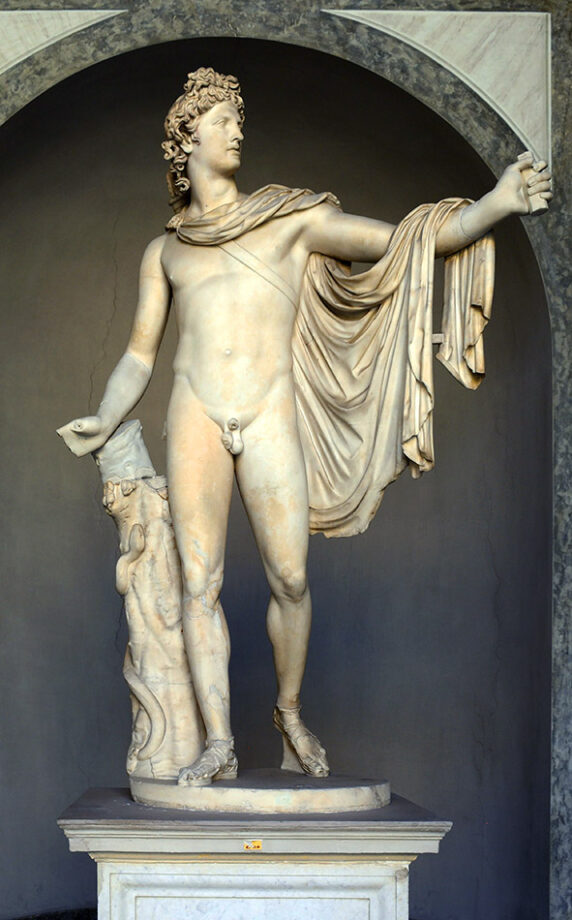
You can also see a life-size plaster cast of the Belvedere Apollo in the Wilcox Classical Museum Collection at the University of Kansas https://wilcox.ku.edu/s/wilcox/item/11600 https://www.museivaticani.va/content/museivaticani/en/collezioni/musei/museo-pio-clementino/Cortile-Ottagono/apollo-del-belvedere.html
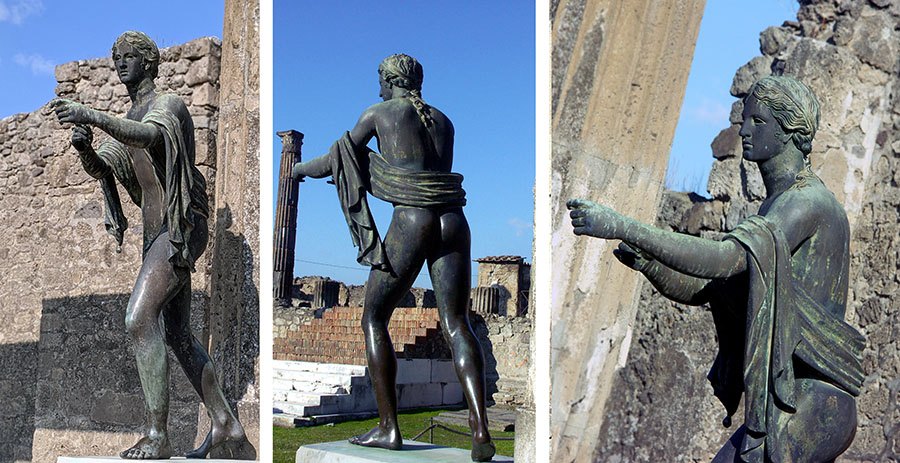
This bronze sculpture of Apollo was buried by the eruption of Mount Vesuvius in 79 AD and was discovered in the early 19th century after the discovery of another bronze sculpture of Apollo’s twin sister Artemis. This statue was conserved at the J. Paul Getty Museum in 2009 and 2010.
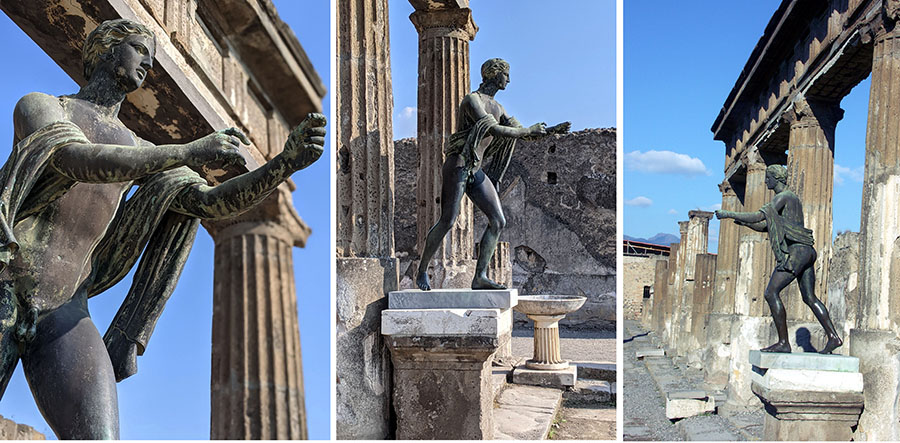
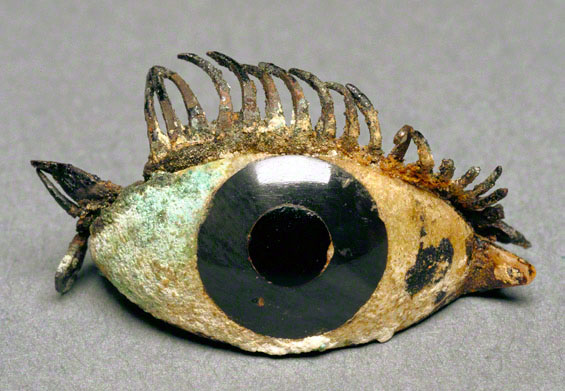
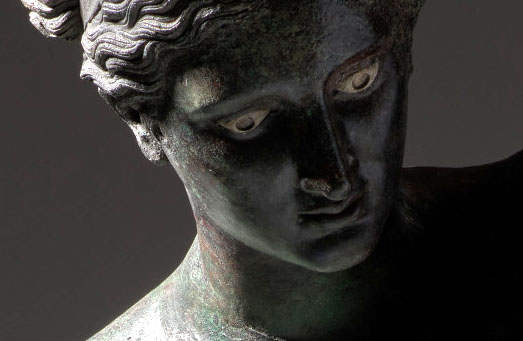
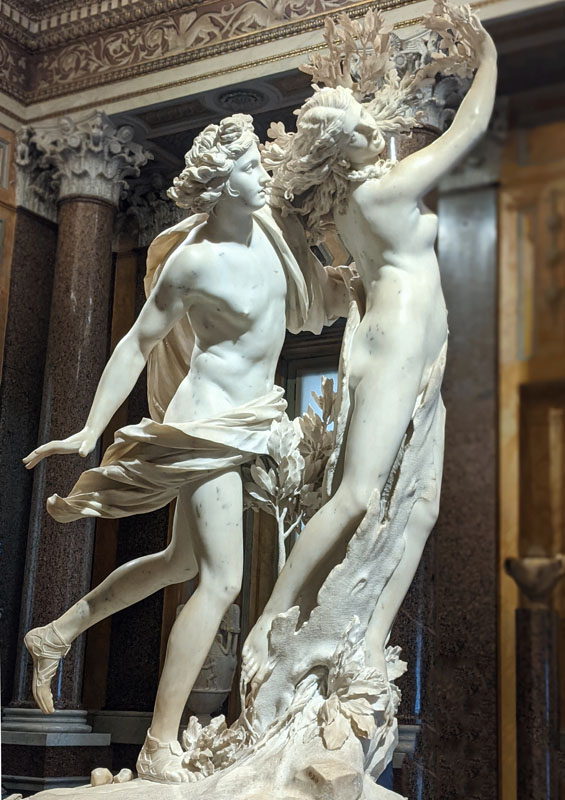
In Greek mythology, Apollo, the god of light, poetry, and music, falls in love with Daphne, a nymph and the daughter of the river god Peneus. Apollo angered the Cupid, Eros, the god of love, by mocking his bow and archery skills after killing the Python. In retaliation, Eros shot two arrows: one hit Apollo with a golden tip, causing him to fall in love with the first person he saw, and the other hit Daphne with a lead tip, making her hate romantic advances. When Apollo chases her, she calls for help from her father. Peneus transforms Daphne into a laurel tree to protect her. Apollo later adorns his lyre with the laurel leaves and crowns the victors with laurel leaves. This depiction of Apollo and Daphne comes from Ovid’s Metamorphoses.
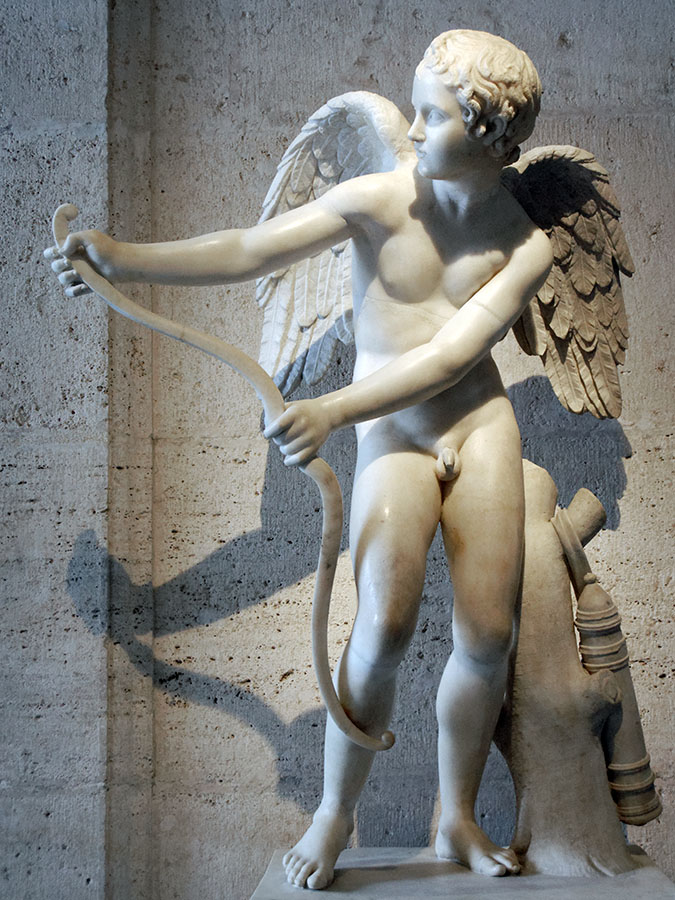
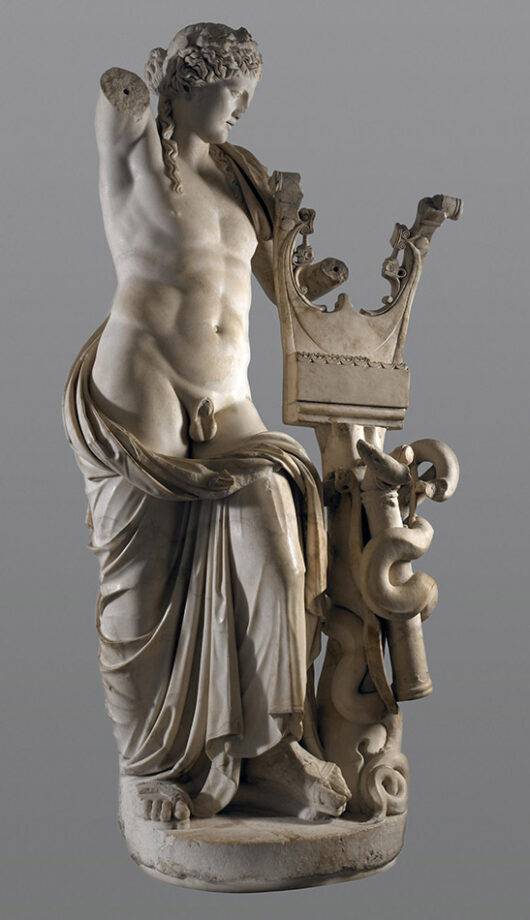
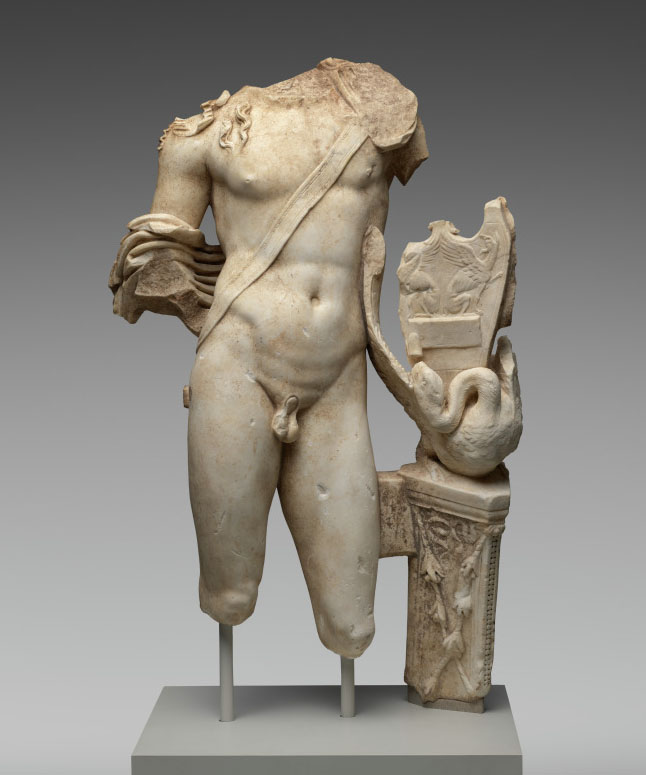
From the museum’s description: Both the kithara, decorated with griffins, and the swan upon which it rests, signify Apollo’s roles as the god of music and leader of the Muses. Apollo received his lyre from Hermes, who invented it. Swans were considered sacred to Apollo because he gave them the gift of prophecy. Swans sing a glorious song before they die, knowing they will soon return to Apollo to be reborn.
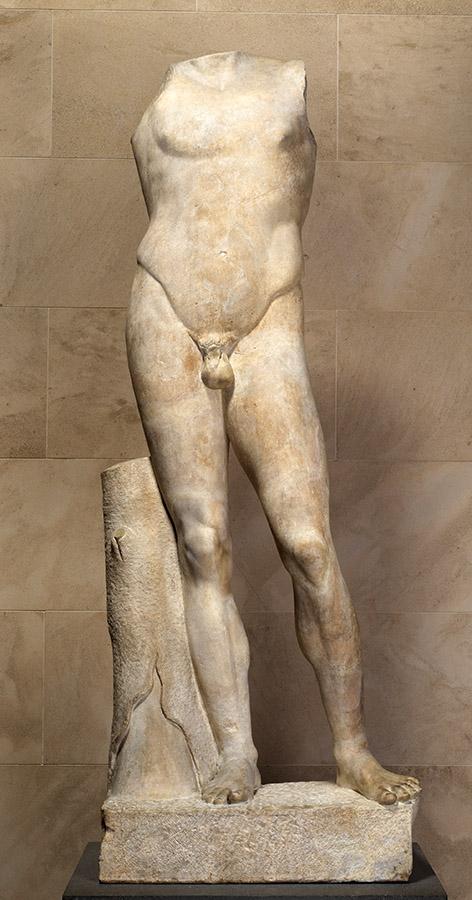
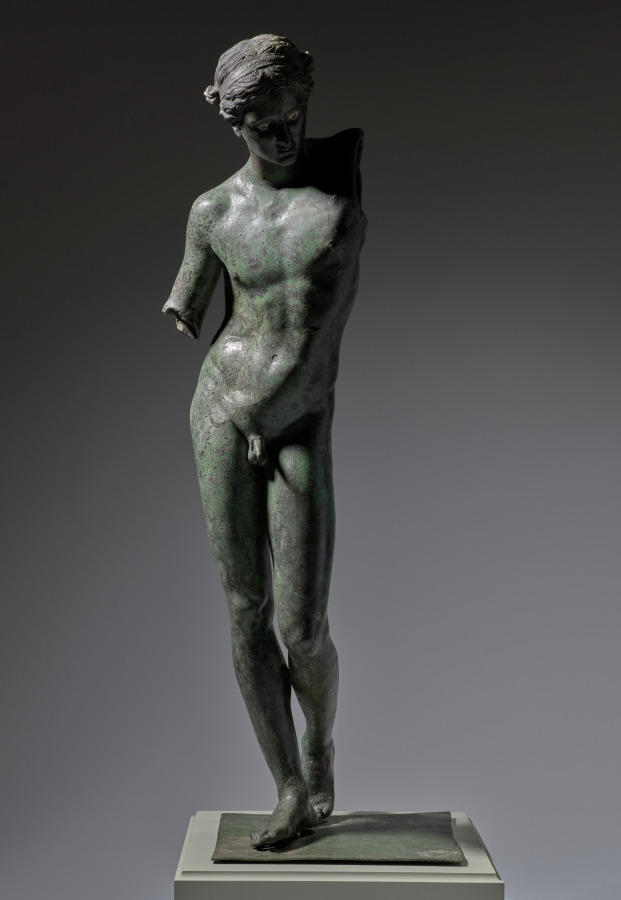
c. 350–200 BCE, The Cleveland Museum of Art, attributed to Praxiteles, (Greek, Athenian, c. 400–330 BCE)
or Follower, Greece, Athens, Bronze, copper, and stone inlay, Overall: 150 x 50.3 x 66.8 cm (59 1/16 x 19 13/16 x 26 5/16 in.), Weight: 52.2 kg
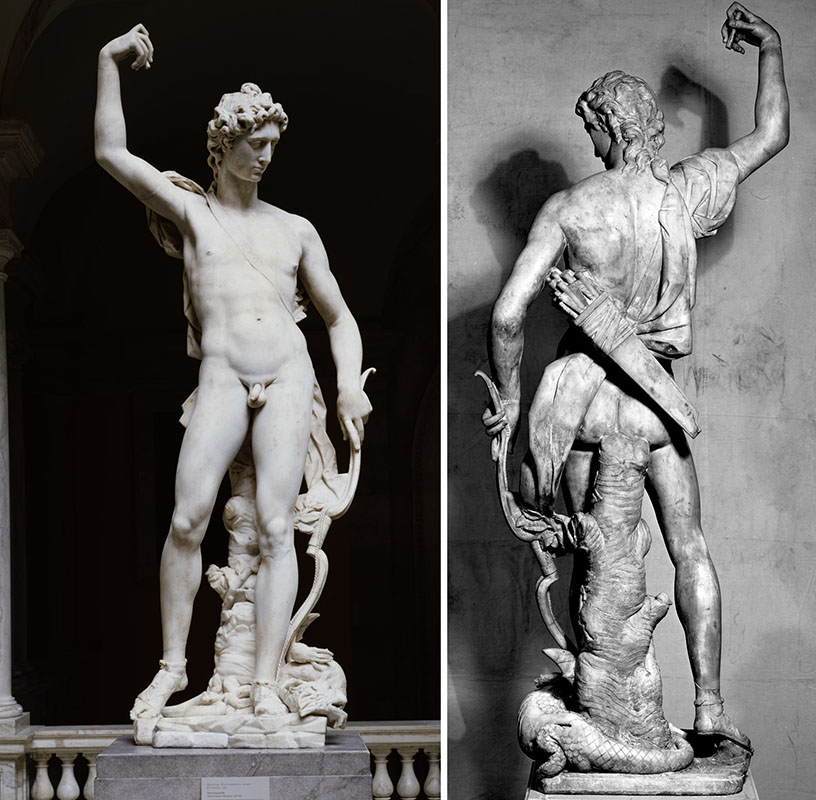
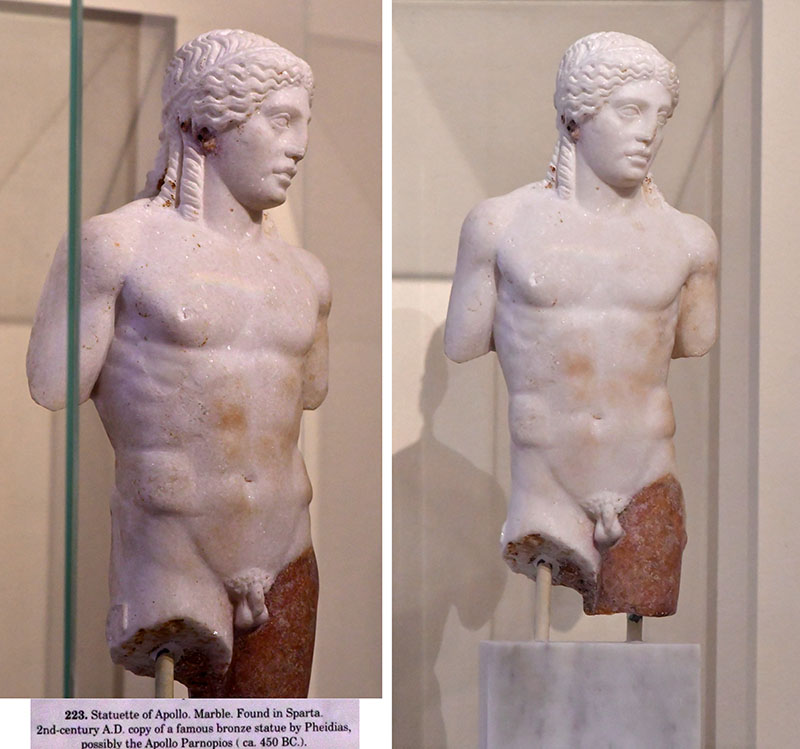
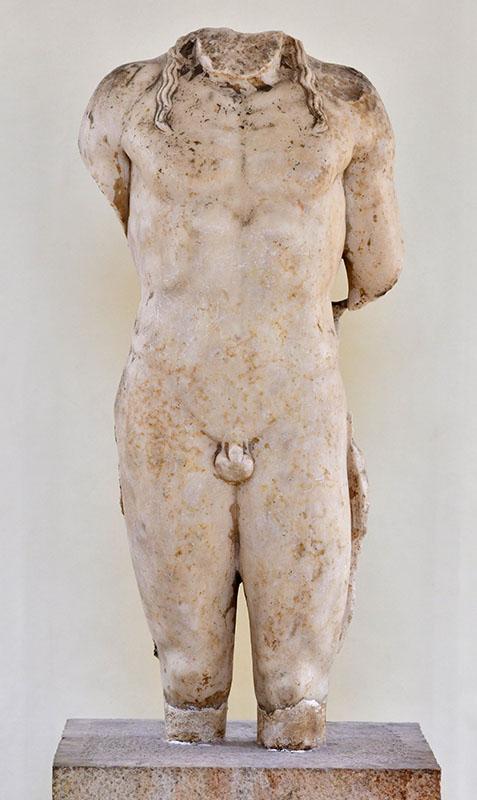
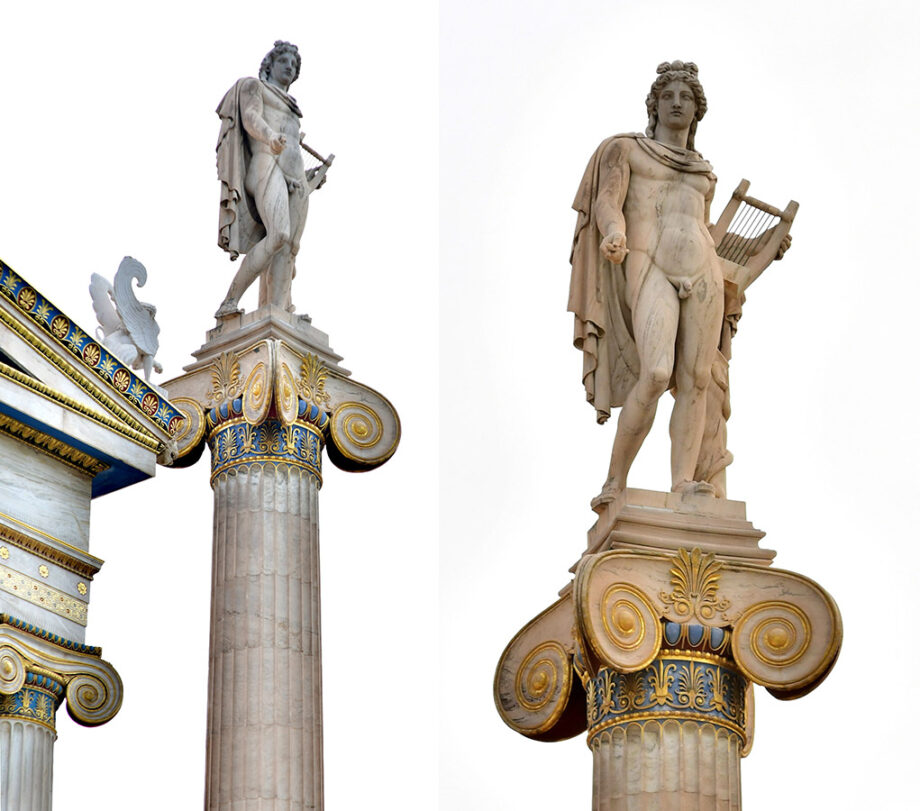
Apollo & Heracles fight over the Delphic Tripod
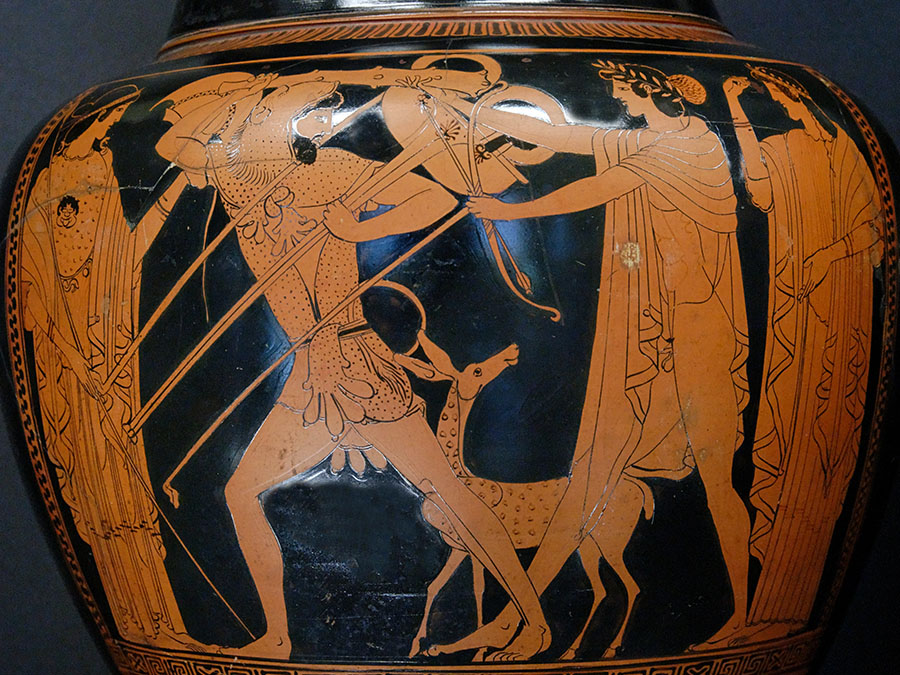
In Greek mythology, Hercules and Apollo, half-brothers by Zeus, fight over the Delphic tripod in a story that appears in numerous vase paintings. Hercules travels to Apollo's sanctuary at Delphi to consult the oracle, but when she doesn't give him the answer he wants, he becomes enraged and tries to steal the tripod to establish his own oracle. Apollo, who holds the tripod sacred, intervenes and the two half-brothers wrestle over it. Hercules is supported by his patron Athena, while Apollo is supported by his sister Artemis. Zeus eventually tries to break up the fight by throwing a thunderbolt between the brothers. After they are separated, Hercules receives an oracle that condemns him to atone for his crime by serving as a slave to Eurytus for three years. Hercules eventually returns the tripod to Apollo and reconciles with him.
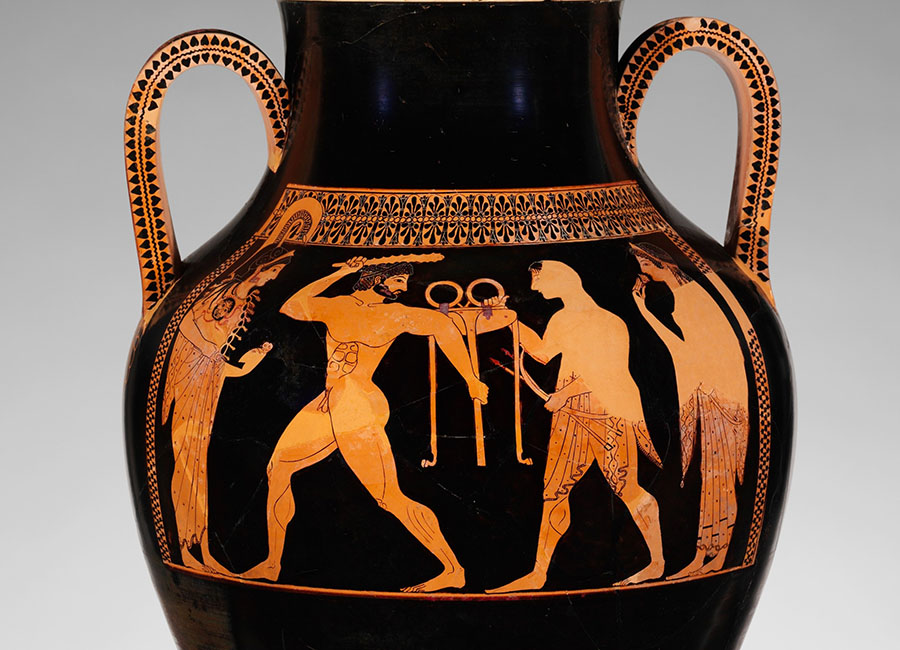
Signed by Andokides, Attributed to the Andokides Painter, Attributed to the Lysippides Painter, ca. 530 BCE
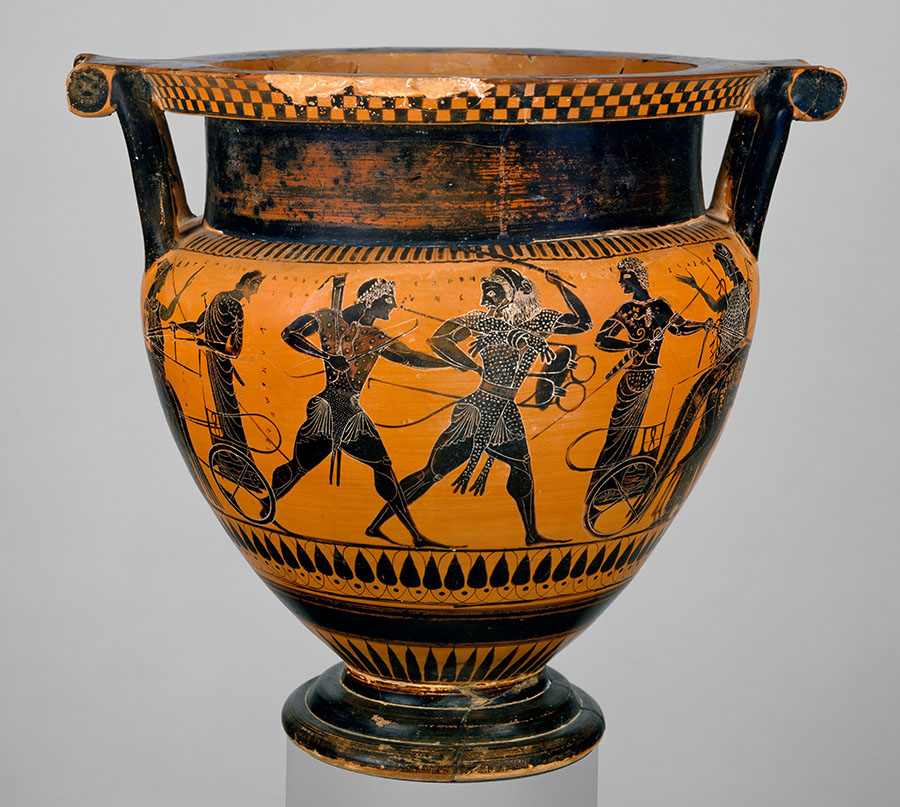
The temple of Apollo in the 4-6th century B.C.
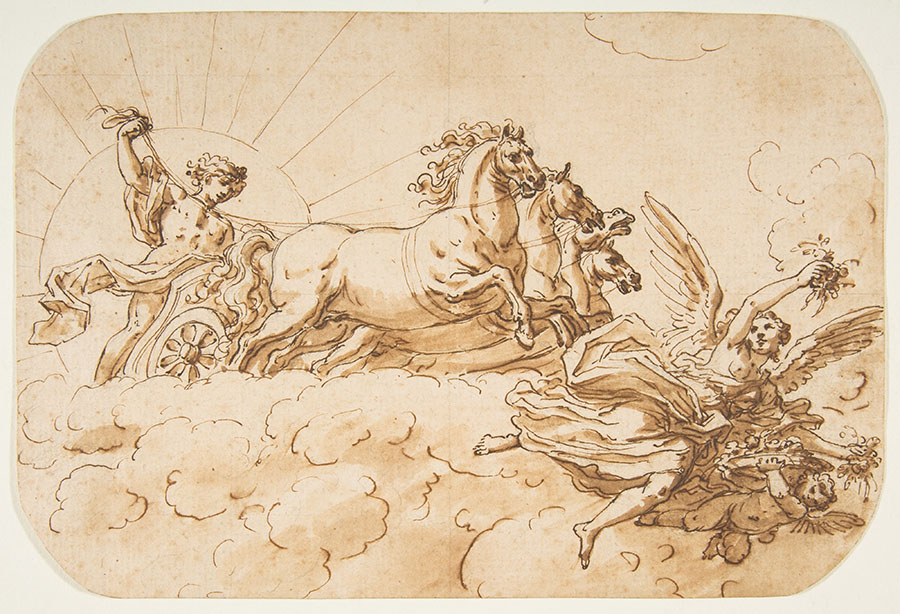
The Temple of Apollo at Delphi was first built of stone in the 8th century B.C. The ruins of Delphi are the third temple that survived until the Romans. This first temple was destroyed in fire in 548 B.C. and the second one was destroyed by an earthquake in 373 B.C. The third and last temple of Apollo was purposefully destroyed with the rise of Christianity around 390 AD. Roman emperors wiped out pagan culture in Greece, including the Sanctuary of Apollo. Both interest and excavations to this site emerged in the 17th century. (International Dictionary of Historic Places, page 183-186.)
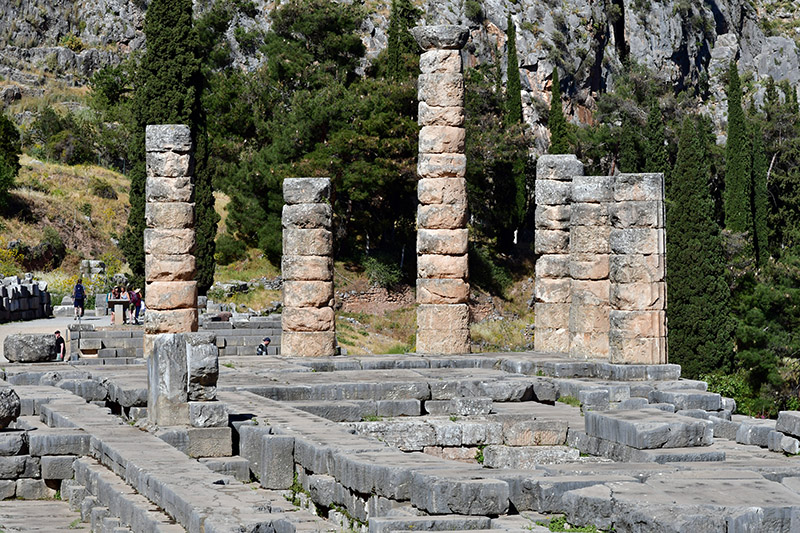
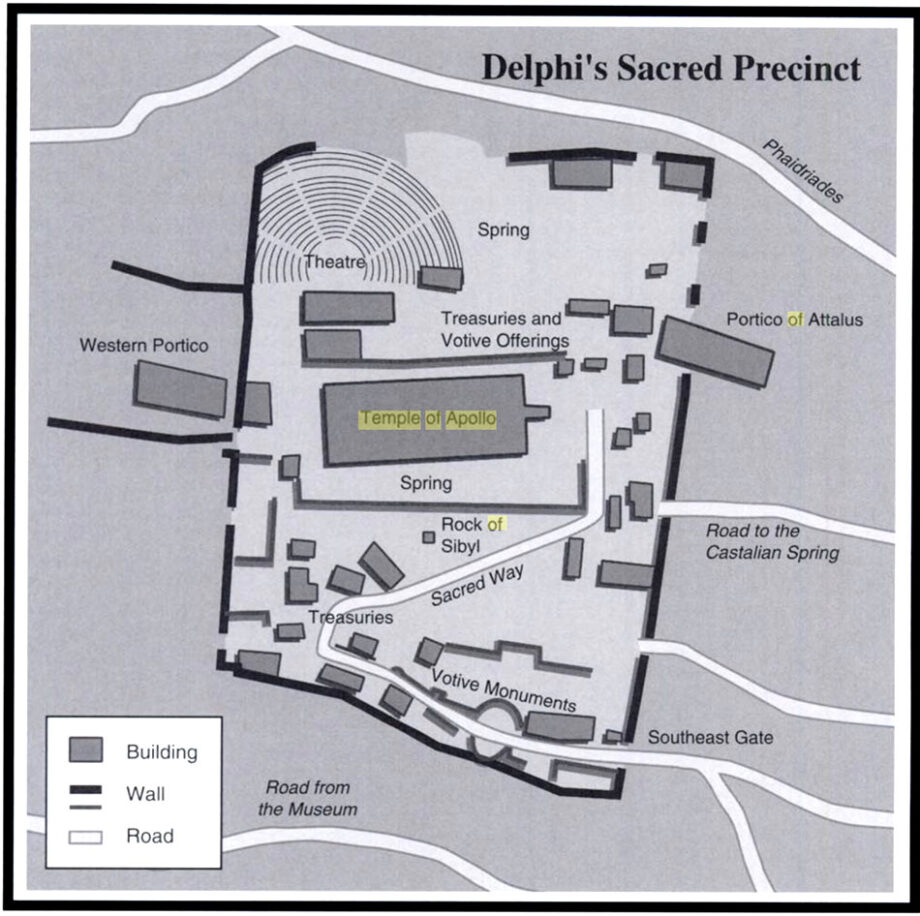
The first Temple of Apollo was the centerpiece of the sanctuary as the abode of the god and the seat of the oracle. By the 6th century BC, its fame had spread throughout the entire world. The first Temple of Apollo was founded by the god himself, according to the Homeric Hymn to Apollo. However, the fire of 548 B.C. destroyed it.
The second temple of Apollo
After the fire, the Temple of Apollo was rebuilt on a much larger scale. The Greeks extended the length of the terrace of the temple. They built a long retaining wall with polygonal blocks and curved joints to keep the ground in place. This construction of the temple lasted for many years and required enormous financing raised in generous contributions of Greek cities, colonies, and foreign rulers. The administration of this new temple was associated with the Alcmaeonids, an aristocratic Athenian family that was living in exile during the tyranny of Peisistratus. The Amphictyony entrusted the completion of the building to the Alcmaeonid family in 510 BC. To receive the god’s patronage as well as the alliance of Greek cities in their struggle against political adversaries, Herodotus wrote that the Alcmaeonids used marble for the temple’s facade. They also hired a famous Athenian sculptor (possibly Antenor) to create sculptures and decorations for the temple. These impressive statues of poros and marble were found in fragmentary condition during the excavations. Placed in compositions, these statues adorn huge gables measuring 2.35 m in height by 19.40 m in width. The result is a visual harmony between restrained sculptural decorations and the austere Doric order of the temple.
The west pediment was decorated with moving figures, depicting the Gigantomachy (the battle between the Olympian gods and giants). The east pediment has static figures in «hieratic stillness» being in awe of Apollo’s arrival at Delphi. Great classical poets and pilgrims praised the Alcmaeonids and the Athenians for the creation of the Panhellenic sanctuary for over a century.
The 373 BC earthquake destroyed the temple of the Alcmaeonids. The rockfall buried much of the construction including the statue of the Charioteer we can see in the museum today. The Amphictyony was busy fundraising for the temple’s construction throughout Greece, but most of the funds came from the fine imposed on the Phocians for looting the sanctuary during the ten-year Third Sacred War. A recorded testimony of plans, financial management, and technical methods of the site’s construction is left in the inscriptions on the stone stelae found during the excavations.
The third temple of Apollo
The third, peripheral Doric temple opened in 330 BC. It had beautiful sculptural decorations set on the pediments that depicted the god Apollo and the Muses on the east side and Dionysus and the Thyiads (or Maenads) on the west side. Persian shields, taken by the Athenians at the Battle of Marathon, were nailed to the metopes.
Archeological excavations didn’t reveal much about the temple’s interior space as it was destroyed to the ground. It’s assumed that the gilded statue of Apollo stood in the cella. There were wall engravings, and the oracular tripod and the navel-stone would be found under the cella’s floor.
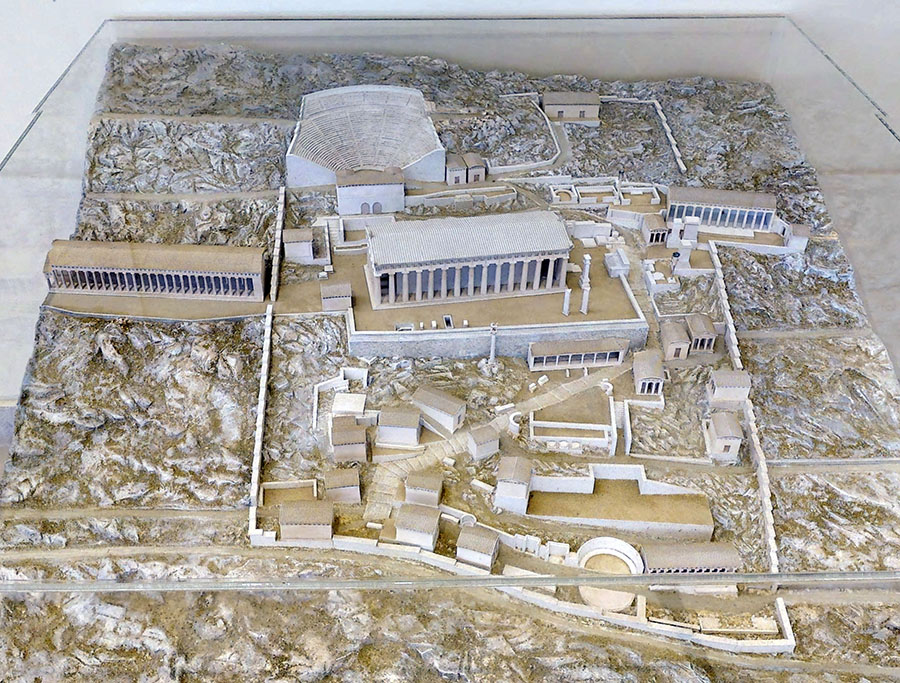
In recent years, the systematic re-examination of several sculptures that had been neglected in the museum storeroom led to their identification. They were the statues of the two pediments which were previously believed to have been carried off by the Roman emperors. This discovery confirmed the description of the pediments given by Pausanias, who had seen the sculptures in situ in the 2nd century AD and provided us with the picture of two compositions shown in fragments in this display.
Art of the Athenian artists lacks the majesty and strength of the Archaic pediments of the earlier temple, but features many innovations in iconography. The depiction of the two gods on the same monument and the unique representation of Dionysus as a kithara player. Apollo, the principal deity of the sanctuary concedes the west pediment of his temple and lends his favorite musical instrument, the kithara, to his brother, Dionysus. It appears that this relates to the official recognition of Dionysian worship at the Delphic sanctuary with the support of the temple priests at the time of the pediments’ construction in 340-330 BC. (*taken from the description inside the museum).
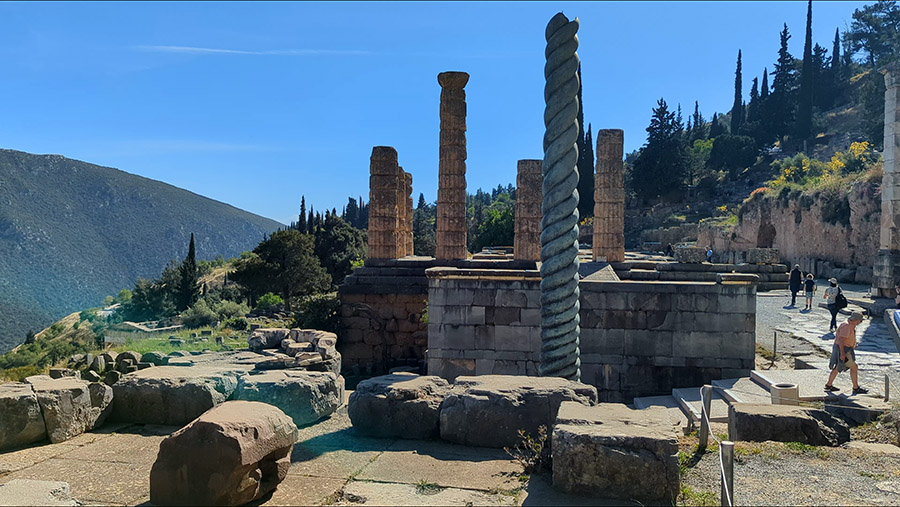
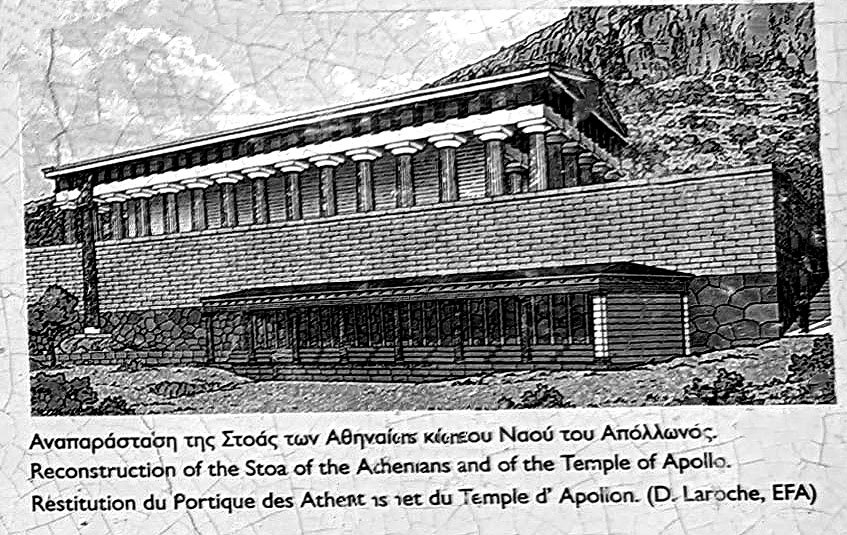
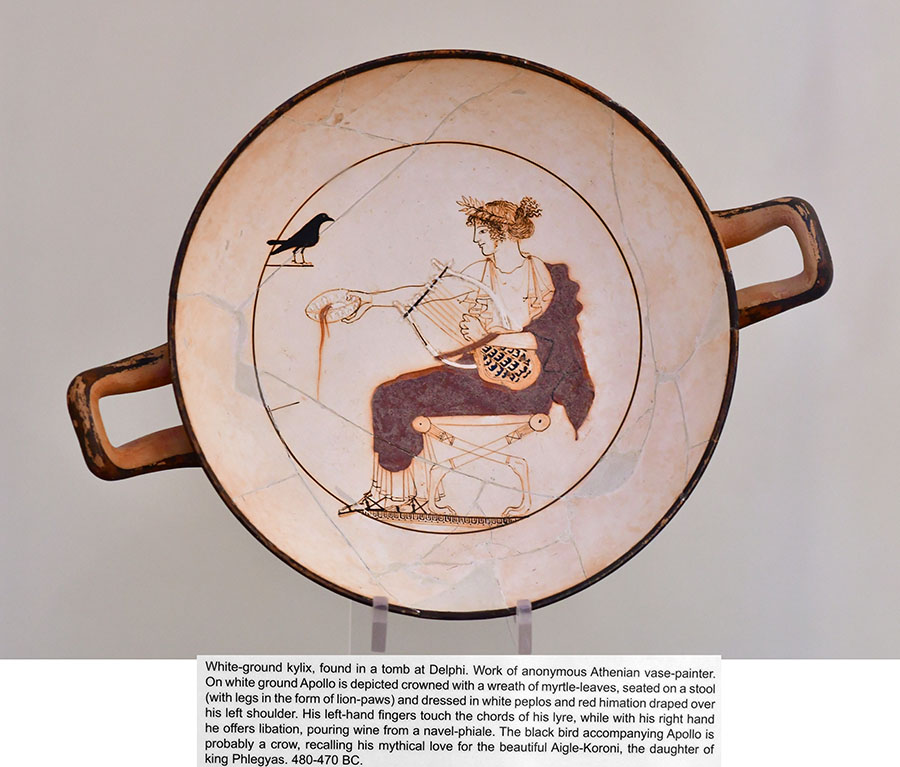
Created by the unknown vase-painter, the artist crowned Apollo with a wreath of myrtle leaves. The god sits on a fancy stool with legs in the shape of lion paws. Apollo wears a white peplos and red himation draped over his left shoulder. He plays the lyre with his left hand and offers libation with his right one, pouring wine. A black bird (a crow) accompanies Apollo, who recalls his mythical love for the beautiful Aigle-Koroni, the daughter of King Phlegyas. 480-470 BC.
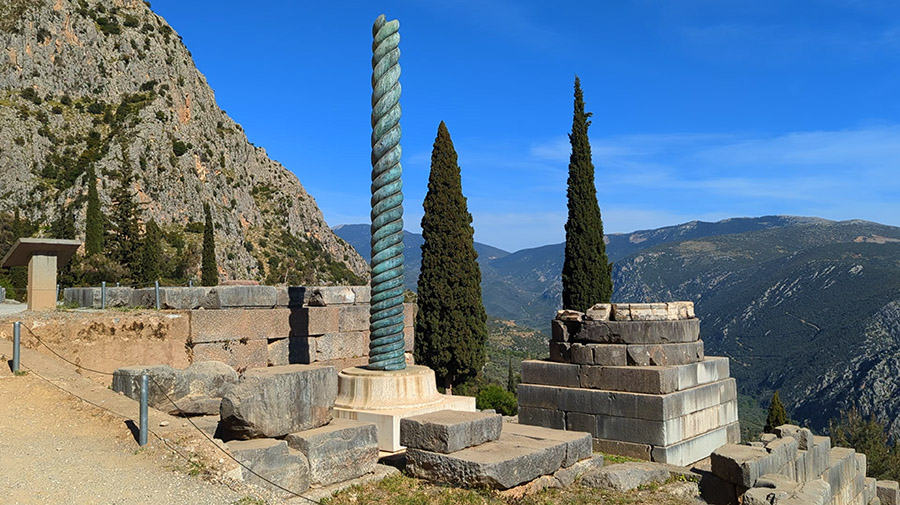
Agora
Agora is a paved rectangular square with 3 stoas reserved for social interaction and commercial meetings that occurred in late antiquity around the 4th century AD. There is only one out of three stoas preserved today. It had shops where visitors purchased their souvenirs and votives. Five small entrances led to the sanctuary of Apollo. The main entrance of the Sacred Way with the Pythian Games’ processions was the place for the Roman Agora in later times.
The Stoa of the Athenians
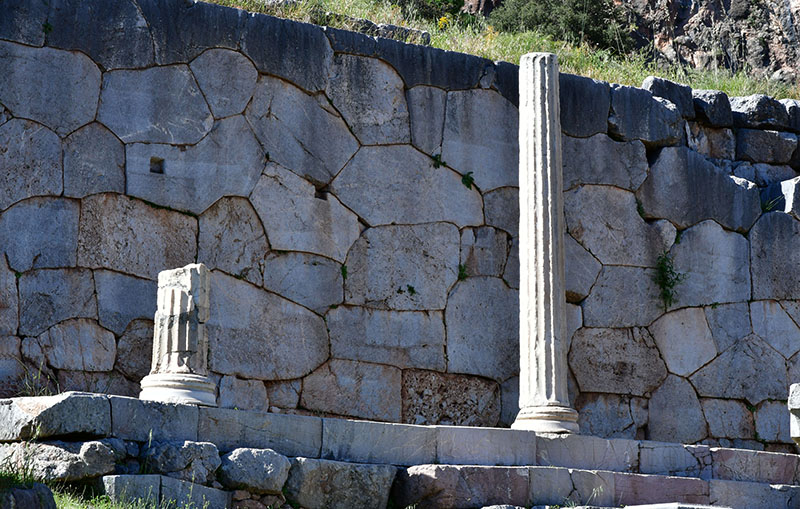
Built between 510- 470 B.C., the stoa of the Athenians was a building in the Ionic style that was located at the center of the Apollo sanctuary. Measuring 30 meters long, Stoa housed the trophies from the Athenians’ naval victories. The facade had seven monolithic marble columns (four of which survive) supporting a wooden roof. The Stoa was supported by the polygonal retaining wall of the Temple of Apollo in its back.
The carved inscription, "ΑΘΗΝΑΙΟΙ ΑΝΕΘΕΣΑΝ ΤΕΝ ΣΤΟΑΝ ΚΑΙ ΤΑ ΗΟΠΛΑ ΚΑΙ ΤΑΚΡΟΤΕΡΙΑ ΕΛΟΝΤΕΣ ΤΟΝ ΠΟΛΕΜΙΟΝ", notes that the Athenians dedicated the stoa, the ropes from the boats and the prow figureheads to the god after defeating the Persians. The building appears to have been constructed with public funds to promote Athens' leading role in the victory against the Persians at the Pan-Hellenic sanctuary of Delphi.
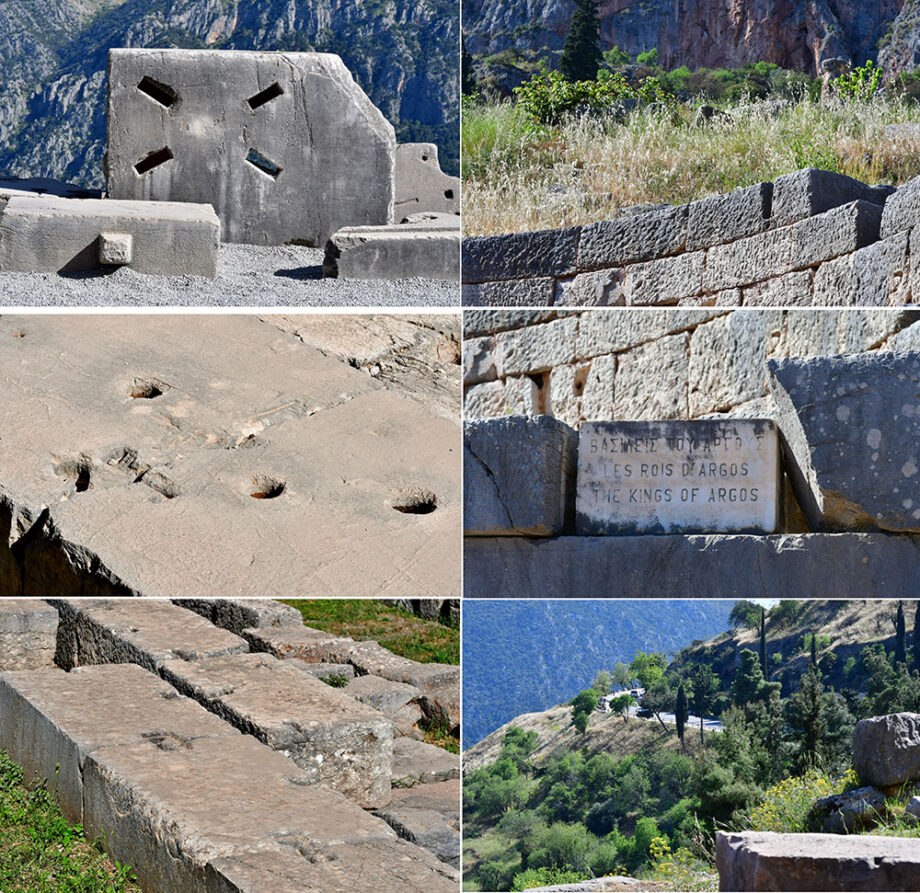
The polygonal wall: The well-preserved polygonal retaining wall of the Temple of Apollo was built in the 6th century B.C. It provided support to the terrace with a temple for centuries. The construction blocks and their perfectly fitted curved joins are a construction that features precision and artistic perfection. Many carvings with about 800 inscriptions stretch across the entire length of the wall.
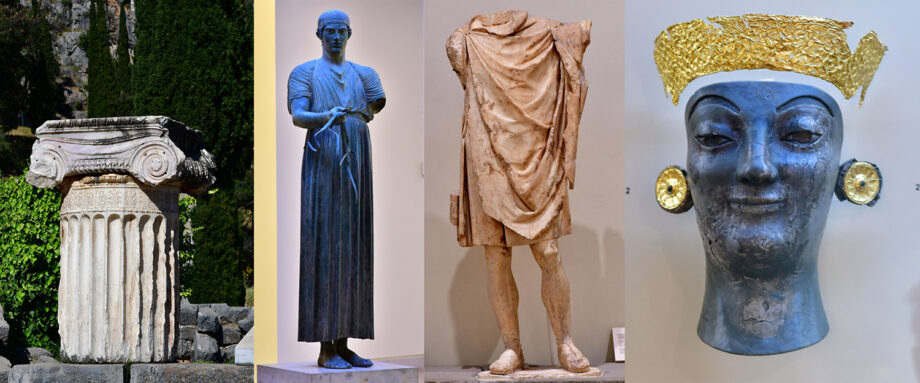
The Sanctuary of Athena
In the Sanctuary of Athena, the goddess was worshipped as the patroness of wisdom, fertility, and health. The eastern part of the precinct retains two porous stone foundations of the Archaic temples dedicated to Athena. These Doric-style temples date to the mid-7th century B.C. and to 500 B.C. respectively. The second temple had a surrounding colonnade consisting of six columns on its narrow sides and twelve columns on its long sides. Its interior consisted of two chambers, the pronaos (porch) and the cella. The cella would have had the cult statue of Athena inside it at that time. The earthquake destroyed this temple in 480 B.C.
The third temple of Athena was made of a local grey limestone in the mid-4th century B.C. in the western part of the precinct. The façade displayed six Doric columns. The opening between the pronaos and cella had two ionic columns. This temple didn’t have a surrounding colonnade.
The winged goddess, Nike was the symbol of victory who expressed the will of the gods in Greek myths. She named and rewarded the winners. Many Nikes were found at the sanctuary in Delphi coming from public buildings.
We can also find some meager remains of the two other buildings built around 500 B.C., located east of the temple. They are attributed to the precinct of the local hero Phylakos (Phylacus). According to Herodotus, the two heroes, Phylakos and Autonoos, defeated the Persians in 480 BC by hurling stones down on them.
The Treasuries
Beyond the Sacred Way monuments you can find the ruins of over 20 treasuries in which gifts to the shrine were displayed. They had various architecture, offerings and dedication. Unfortunately, not much is left but the stones of some foundations. However, the Doric temple Treasury of the Athenians is reconstructed to view.
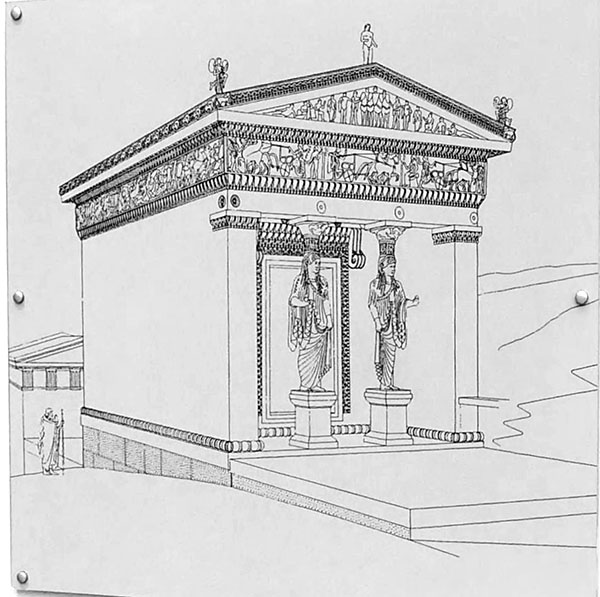
Created in the Ionic order, the treasury was the first one built out of marble completely around 530 BC. It consisted of 3 types of marble – Siphnian, Naxian, and Parian. This treasury had rich sculptural decorations, some depicting scenes from the Trojan War. It was painted in bright colors of blue, red, gold, and green.
The pediment over the façade of the treasury depicted Zeus attempting to prevent Hercules from stealing the Delphi tripod. The marble roof had sculptures and gutters depicting the lion’s heads. The pediment also had sculptures of Nikes and a sphinx.
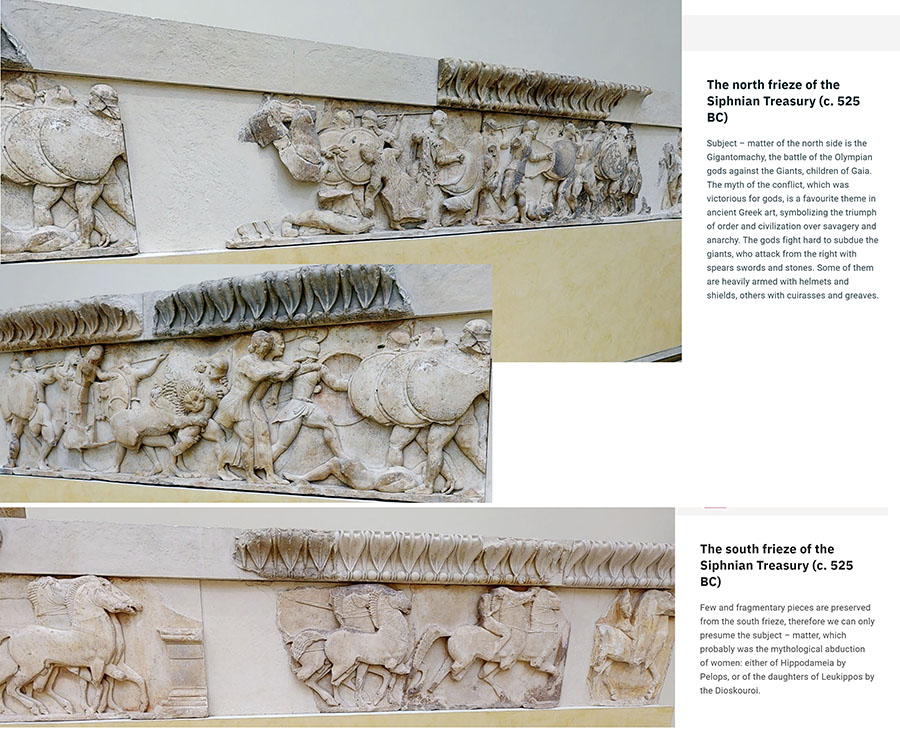
There are two, small treasuries present among the non-religious structures in the precinct of Athena Pronaia. These treasuries were dedicated sanctuaries. One Doric-style treasury dates back to the 5th century B.C. The second one is called the Treasury of the Massaliots. (Greek colonists of Massalia, modern Marseilles, who came from Phocaea in Ionia). Built around 530 B.C., it looked like a small temple. The ionic order treasury consisted of gleaming Parian marble with two columns in its façade. The columns had the Aeolic capitals.
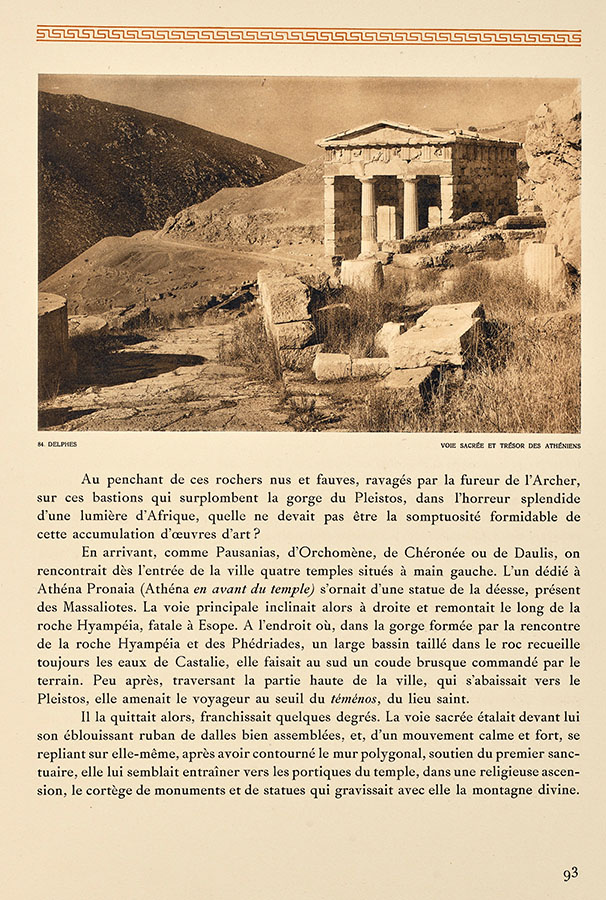
View of a sacred pathway in Delphi. The path faces the Treasury of the Athenians.
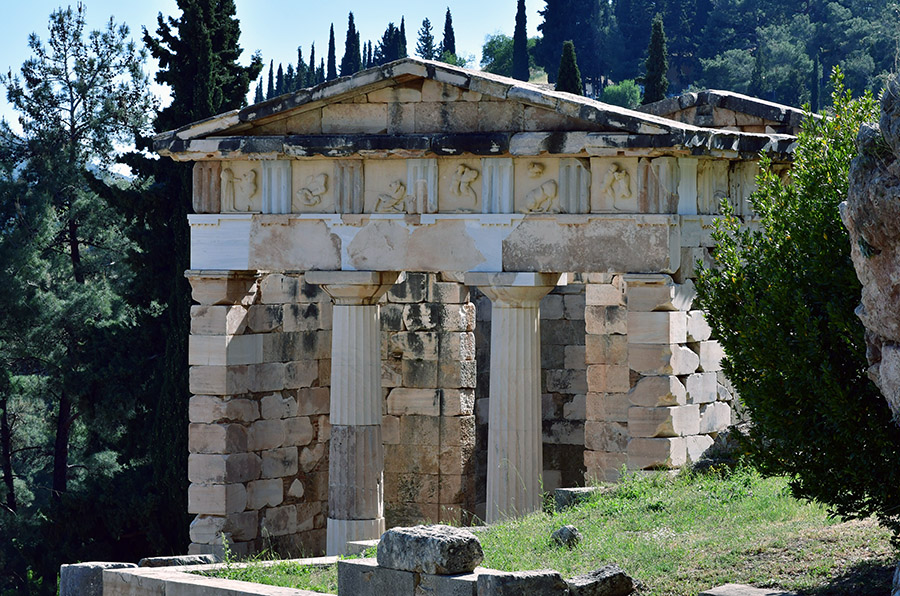
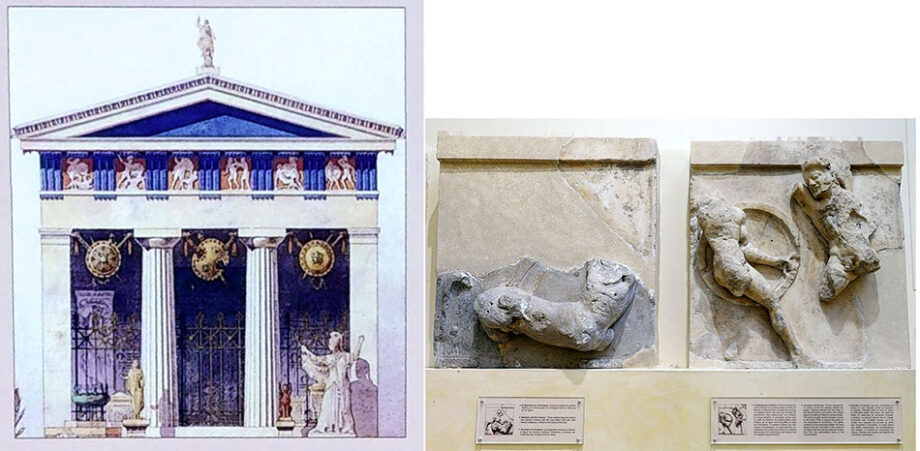
We can find the stelae foundations left in front of the two treasuries. Their inscriptions recorded confiscations and debts to the sanctuary. In addition, Greeks placed a single pedestal with the Delphic trophy that marked the expulsion of the Persians in 480 B.C.
To the North of the Treasury of the Siphnians stand the remains of the Treasury of the Megarians, dated to the end of the 6th century B.C. The building had several reconstructions and some have over 40 inscriptions, referring to the Megarians, dating to the 5th century B.C. The foundations and the wall with the inscriptions were restored in 1976.
The Sicyonian Treasury got built in the 6th century B.C in 3 phases, replacing two older monuments. It was dedicated to the victorious presence the tyrant of Sicyon Cleisthenes in the First Sacred War. It’s believed that one of the buildings contained the chariot with which Cleisthenes won the chariot race in the first Pythian Games of 582 BC.
The Theban Treasury was created of limestone in the Doric style. Situated on the Sacred Way in the Sanctuary of Apollo, it was dedicated to the Thebans’ victory at Leuktra in 371 B.C. This was a rectangular building (12.29 x 7.21 meters). The local limestone of St. Elias was dark grey with some bluish shades that made it look plain, especially in comparison to the Treasury of the Siphnians. The architect made a lot of effort to design a very stable structure, decorated with a frieze, metopes, and triglyphs in white marble. It probably had no columns but doors and a window illuminating the cella.
The Cyrenaean Treasury or the Treasury of the Cyreneans was probably the last treasury built in the sanctuary of Apollo. Dating back to 334-322 B.C., the Doric-style building was made of Pentelic and Parian marble. The roof was made of marble as well with gargoyles in tubular and leonine forms. The engraved inscription suggests that it was an offering as a reward for the wheat they had offered during a famine.
The eastern edge of the precinct contains the remains of various altars, dating back to the 6th century B.C. Their inscriptions hold the names of the Gods to whom they were dedicated, including Zeus, Athena Ergane, Athena Zosteria, Eileithyia, and Hygiea.
The Theatre & The Pythian Stadium
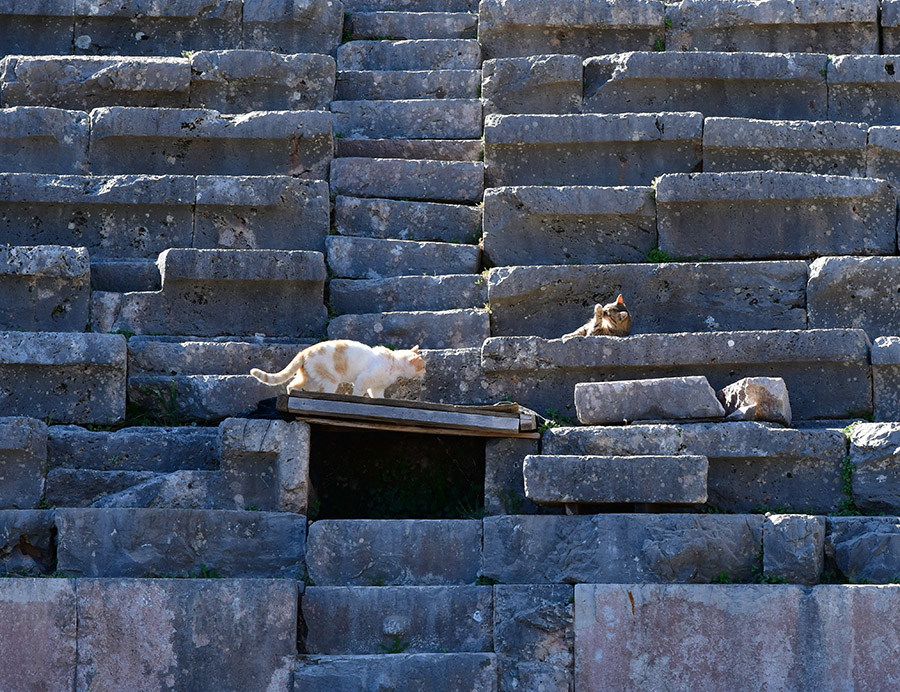
The theatre is considered the best-preserved monument in Delphi and in Greece. The Delphic theatre hosted musical and religious festivals, oracular rituals, and the Pythian Games dedicated to the victory of Apollo over the Python. The stadium was built around 450 BC where the Pythian Games began as musical contests. The ruins of the theatre and stadium have been excavated together.
The stadium that hosted the games is partially built into the side of Mount Parnassus. The original architectural finish of the theatre is unknown. It’s speculated that the spectators sat on wooden seats or the ground. The first theatre was made of stone in the 4th century BC.
The restoration took place around 160 B.C. with the funds of Eumenes II, king of Pergamon. The theatre’s present shape dates back to the early Roman period (1st century AD). The stones used for its construction came from the Mount Parnassos. The deep amphitheatrical shape had a seating capacity of 5,000 people. It was divided into two sections by a transverse corridor comprising 35 rows of seats.
The backstage flanked by two wings faced the seats and orchestra. There is only a foundation of this setup left today. Its facade, proscenium, or the part of a theatre stage in front of the curtain, was embellished with a relief frieze. The frieze depicted the labors of Herakles, now exhibited in the Archaeological Museum of Delphi. The frieze was probably added during the restoration period of 67 AD, at the time of the Roman emperor Nero’s visit to Delphi. Parts of the theatre walls have embedded inscriptions regarding the emancipation of slaves.
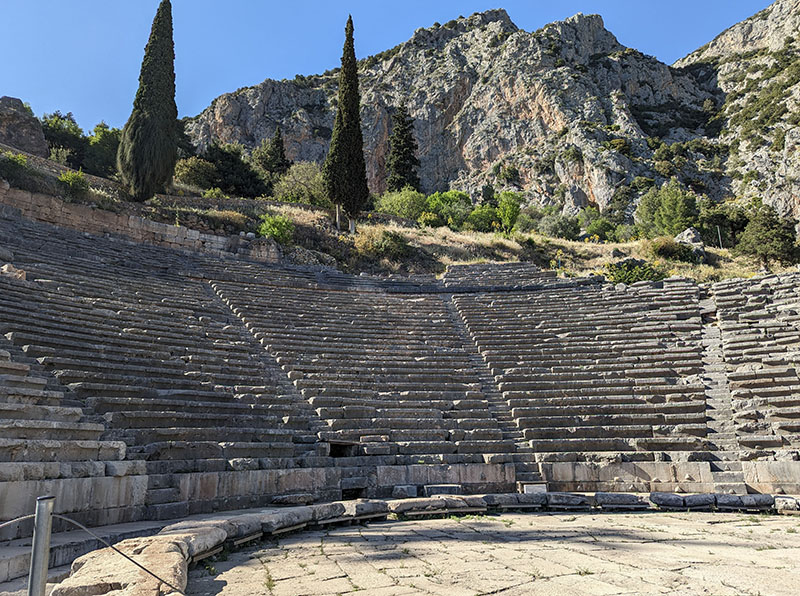
The games were one of the four Panhellenic Games, along with the Olympic, Nemean, and Isthmian Games. The Pythian games originated in the 6th century B.C. and continued until the 4th century AD. The Pythian games featured competitions in a variety of events, including athletics, music, poetry, chariot races, declamation, reading aloud, rhetoric, singing, and drama. This event was more than just a game. It was a big social and musical event with international crowds, diplomats, and politicians showing their power. The winners of the athletic games brought fame to themselves and their cities. They also received trophies in the shape of tripods and laurel leaves.
Built around the 4th century BC, the stadium of Delphi was about 178 meters long, situated at the highest spot in the sanctuary above the theatre. According to some inscriptions, it was called the “pythikon stadium” or the Pythian stadium. The total capacity of the stadium was about 6500 people. The stadium was abandoned in 394 A.D. Covered with earth, it became a place for pasture.
The Stadium of Delphi is the best-preserved stadium in Greece. It had 4 different constructions with tracks for athletes to compete. In the Roman period, they raised the track but reduced its length. The northern side of the stadium preserved 12 rows of seats divided by staircases in 12 tiers. The eastern side has a well-preserved start line, with two rows of slabs bearing incisions for the feet.
The gymnasium
The word ‘gymnasium’ came from the Greek word gymnós, meaning “nude”.
Dated to the 4th century BC, the Gymnasium of Delphi is nestled between the Castalia fountain and the sanctuary of Athena Pronaia. It consisted of several buildings including baths and restaurants. The running track (paradromis) was 6 meters wide and 172 meters long. The upper terrace had a long portico of 83 Doric columns used for athletics (xystos), which measured 9,05 x 185,95 m, the length of a Pythic stadium. Sand covered the floor for athletes to exercise. The lower terrace had the Palaestra ( ancient Greek wrestling school) and a pool with a sanctuary.
Monuments of the Sacred Way
The Sacred Way in Delphi was a short road that led up to the temple of Apollo. The stone paving slabs covering the Sacred Way belong to late antiquity. Lined up with incredible monuments, sculptures, and treasuries on both sides, this road represented the wins in ancient Greek history as the Greeks and the wealthy made these offerings to the gods. As such, Delphi was an important art center because skillful art and sculpture were created by famous Greek artists and offered as votives to the gods. Unfortunately, only the bases of these incredible monuments exist today. However, they have so many inscriptions there that the Delphic sanctuary is probably the largest open-air library of real ancient texts in existence now.
The serpentine column was the closest to the altar standing next to a bronze sculpture of Apollo (now missing).
One of the famous votives originally placed near the Temple of Apollo was a bronze bull (now missing) with a stone base existing today. Presented by the Corcyrans, this sculpture was made by Theopropos in the 5th century BC.
The votive of the Arcadians consisted of 9 bronze statues including Apollo. The Arcadians dedicated it to Apollo after they plundered Laconia in 370 BC. Only the base exists today.
There were two different votives of the city of Argos, one glorified their victory over the Spartans in 457 BC.
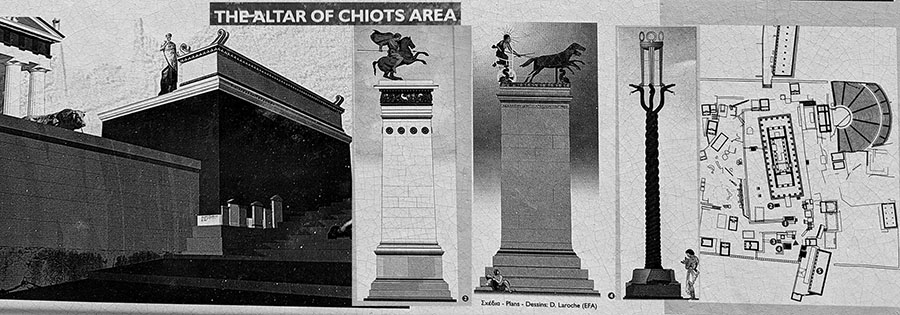
The Altar of the Chiots. The people of Chiots paid for this monument in the 5th century BC. There is an inscription on the base of the altar stating that the Chios had the right to consult the oracle before other Greeks.
2. Aemillus Paulus statue on a pedestal. This is the equestrian statue of the Roman consul who defeated the king of Macedon Perseus at Pydna in 168 BC. The statue stood on a 12-meter base and the pedestal’s frieze depicted the battle scenes from the battle of Pydna. This is considered the first historical relief, in which the Romans defeated the last Greek Macedonian king. The frieze is on view at the Museum of Delphi.
3. The Sun God statue on a pedestal. Located behind the Serpentine column as a foundation only today, the pedestal supported a gilded chariot of the Sun God, Ilios, patron of the island of Rhodes. This monument became the votive of the Rhodians in the late 4th century AD.
4. The Tripod of the Plataeans or the Serpentine Column. All 31 states of Greece contributed to the creation and installment of this votive monument in Delphi.
The Delphi tripod was an offering to the god Apollo from the Greeks who won over the Persian Empire at the Battle of Plataea in 479 BC. The Greeks collected the spoils of their victory and dedicated 1/10 of it to cover the cost of making the golden tripod with caldron. The golden tripod was set on a 7.5m tall, bronze column with a 3-headed serpent.
The Phocians melted down the gold from the tripod during the Third Sacred War (354-343 BC), while Constantine the Great transferred the serpentine column to Constantinople, founded in 330 AD. It still stands in the Hippodrome area in Istanbul, Turkey.
* These museum descriptions are adapted to English for a better reading experience.
The Serpentine Column
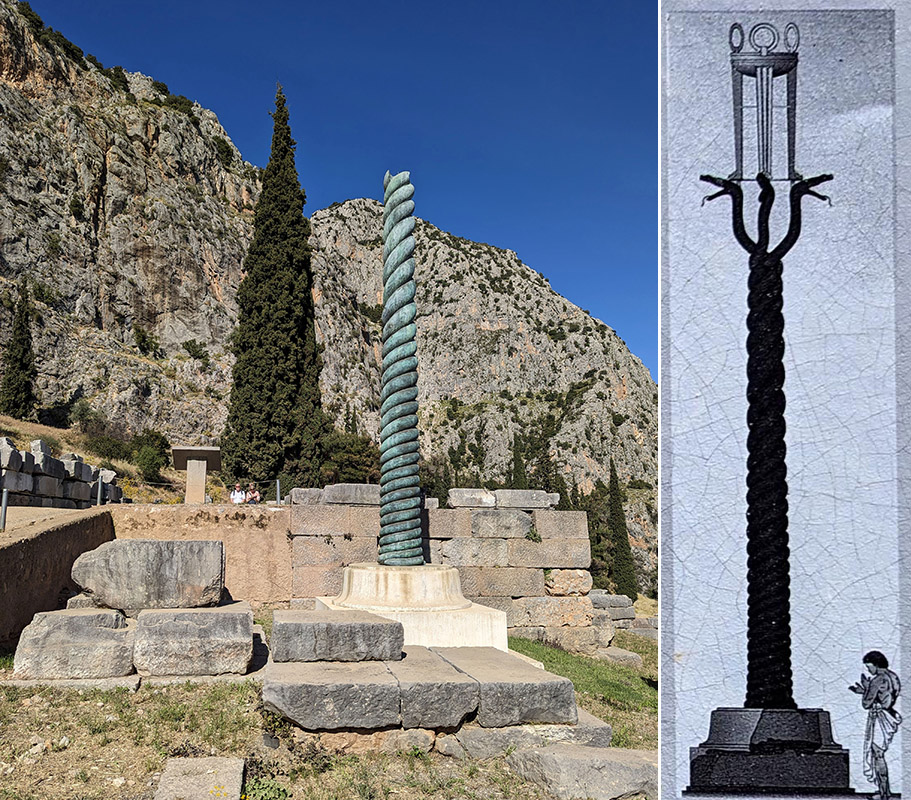
The serpentine column consisted of an inscribed base with 13 coils (inscribed 31 Greek states who fought with the Persians), three bronze intertwined snakes, and a golden tripod with a cauldron (long missing). Based on some Ottoman illustrations, the serpent heads existed at the top of the column until the 17th century.
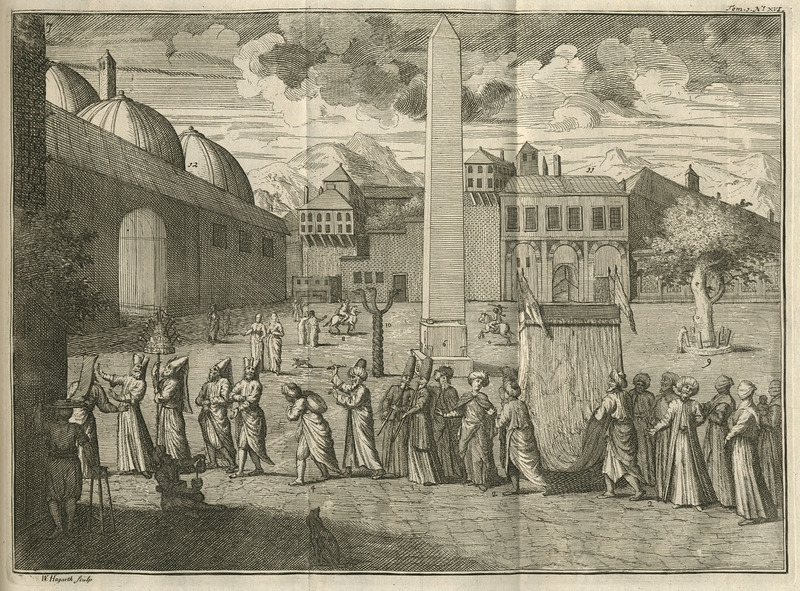
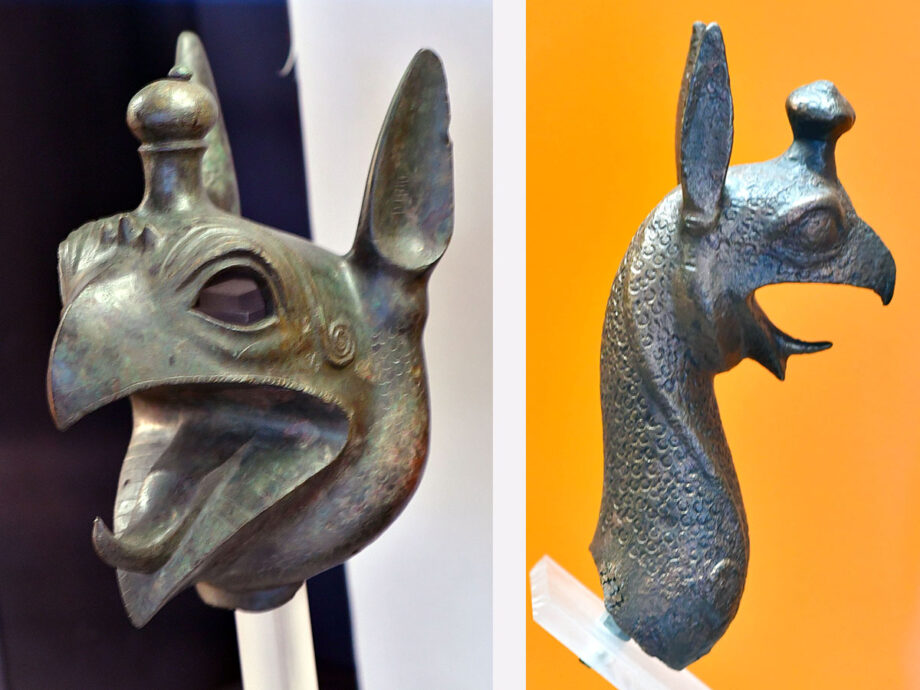
The votive offering of Daochos
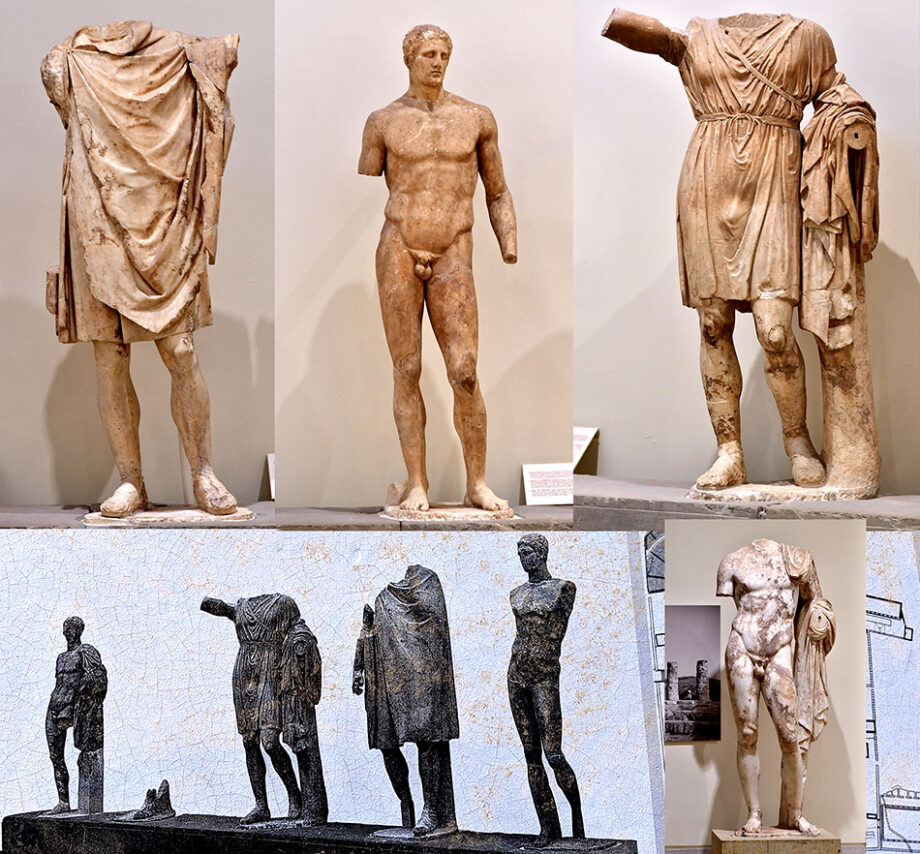
The offering consisted of nine statues placed on a long, narrow base. This sculptural group is one of the most important offerings made by a private person to the Delphic sanctuary of Apollo. According to the inscription on its base, the offering was commissioned by Daochos II of Pharsala, tetrarch of Thessaly and hieromnemon (Sacred Recorder) of the Delphic Amphictyony, 339-334 BC. At the right end stood a statue of Apollo. Next to the god stood six statues of Daochos’s ancestors starting with the genarch Aknonios, who presents his family to the god as follows: Agias, Telemachos, Agelaos, Daochos I, Sisyphos I, Daochos II himself, and his son, Sisyphos II.
The inscription mentions the names and most important accomplishments of the family members. The statue of Agias (top center), great-grandfather of Daochos II a renowned athlete of the pankration in the 5th century BC. He was a repeat winner in all of the Panhellenic games. This group is attributed to the famed sculptor Lysippos or his school. * Taken from writing inside the Museum of Delphi.
The giant Naxian Sphinx
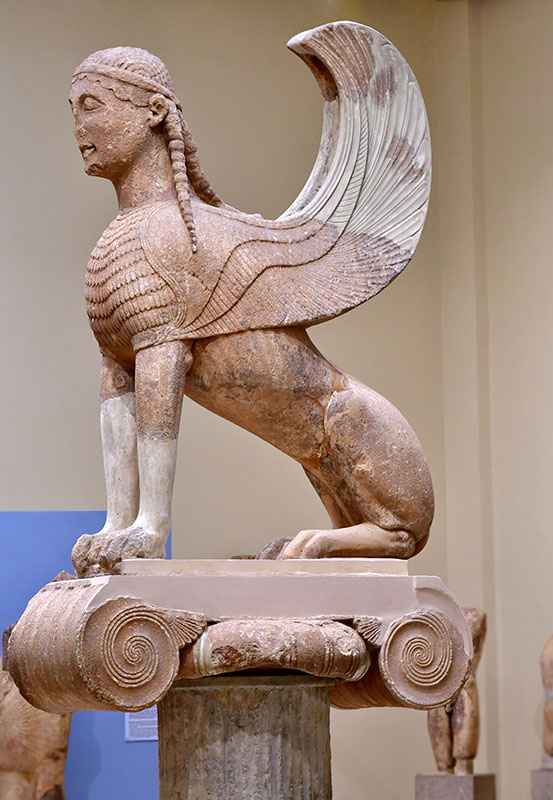
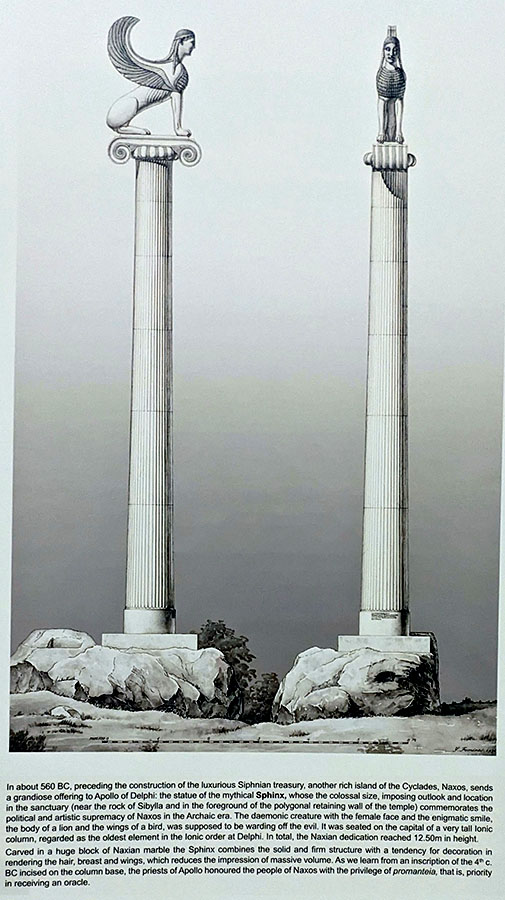
The Naxian Sphinx was created around 560 BC, preceding the construction of the Siphnian treasury –
a building at the Ancient Greek cult center of Delphi, in which the priests hosted the offerings from the city of Siphnos. The building stood on the “Sacred Way” road going through the Sanctuary of Apollo.
Naxos, a wealthy island of the Cyclades, sent a gigantic offering to the Sanctuary of Apollo of Delphi – the statue of the mythical Sphinx. Its colossal size, imposing appearance, and location in the sanctuary (near the rock of Sibyl commemorated the political and artistic supremacy of Naxos in the Archaic era.
This demonic creature with a female face and enigmatic smile was supposed to be warding off the evil. Placed on the capital of a 12.50m tall ionic column, the sphinx became the oldest element in the ionic order in Delphi.
Greek Kouros
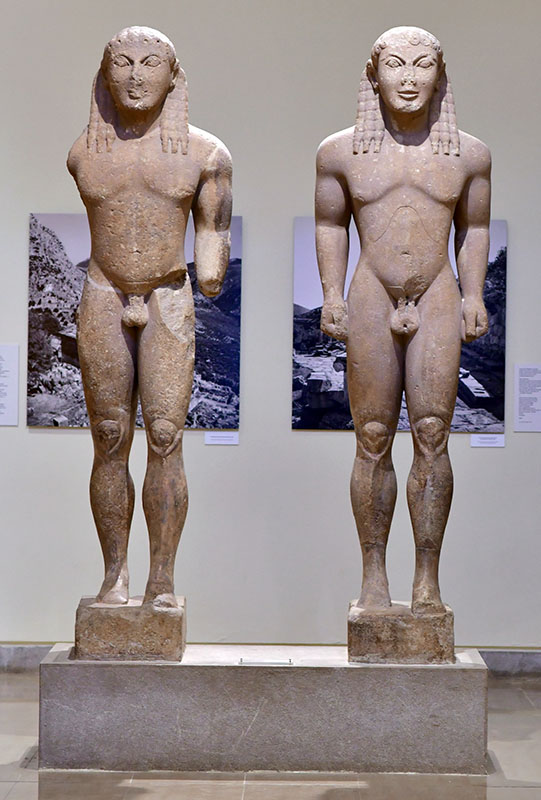
According to the museum’s description, Herodotus tells us a myth about two brothers, Kleobis and Biton. They helped their mother, Hera, to pull her chariot to the sanctuary and as a reward, the goddess granted them a peaceful death in their sleep.
The Charioteer
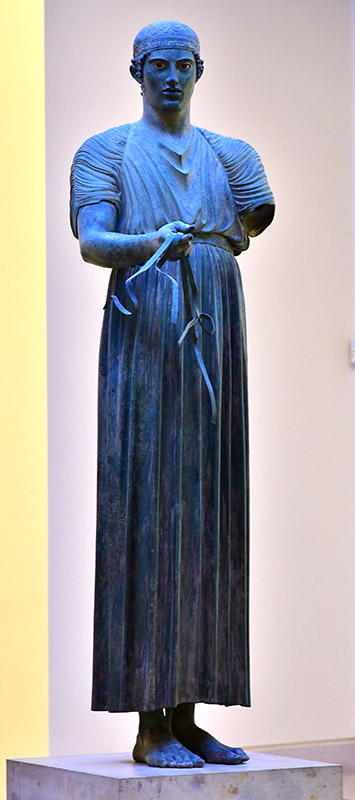
This well-preserved monument was part of the votive offering received after the Pythian Games. Wearing a chiton, the figure stood on his chariot with horses. He has the eyes inlaid with glass and stones. The figure is reminiscent of a Doric column repeating long and simple lines in his clothing. His beautiful feet and slender figure make me think of a female form although his hair is short and a simple band around his head speaks of his victorious status.
Horseshoe-shaped monument
This monument had over 18 marble sculptures dating to the 3rd century BC. One of the statues shows “the Delphi Philosopher.”
The Lesche of the Knidians
Lesches were places for public gatherings in antiquity. Located not far from the Theatre, the lesche looked like a rectangular hypostyle chamber built around 5 century BC. (Hypostyle is a building with a roof supported by pillars in many rows).
It became famous because of the paintings depicting the Fall of Troy and the Odysseus Descent to Hades done by a famous artist- Polygnotus.
The column with the dancers
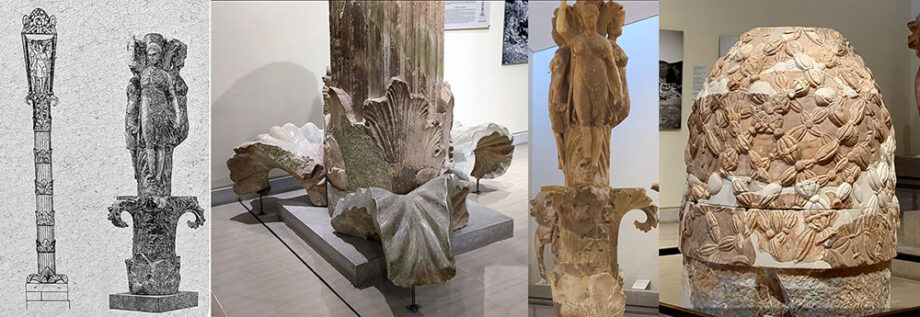
Decorated with the acanthus leaves, this base supported an 11m column with 3 dancers at its top. It’s speculated that the omphalos stone crowned the column with dancers. Their height exceeds 2m, while originally the column was around 11m high.
The Statue of Antinoos
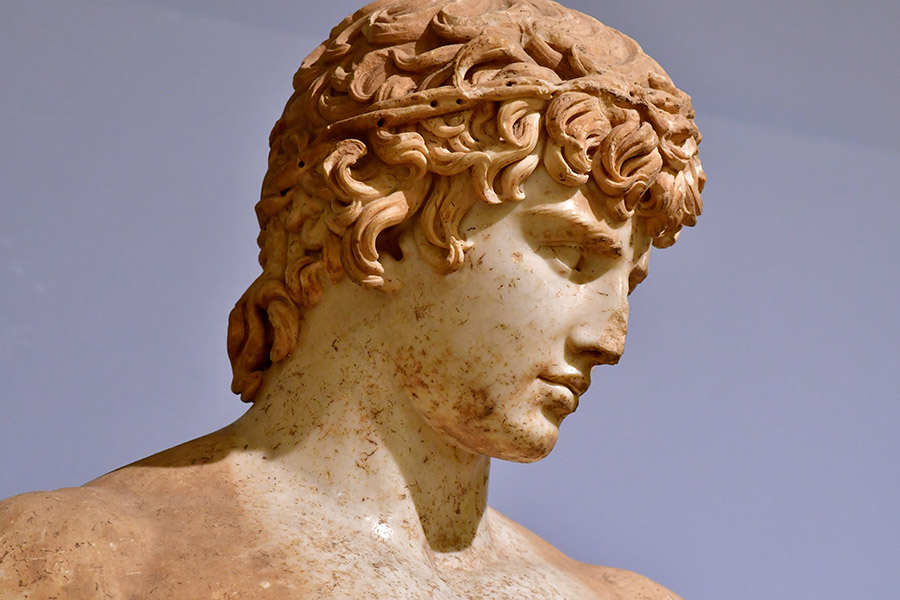
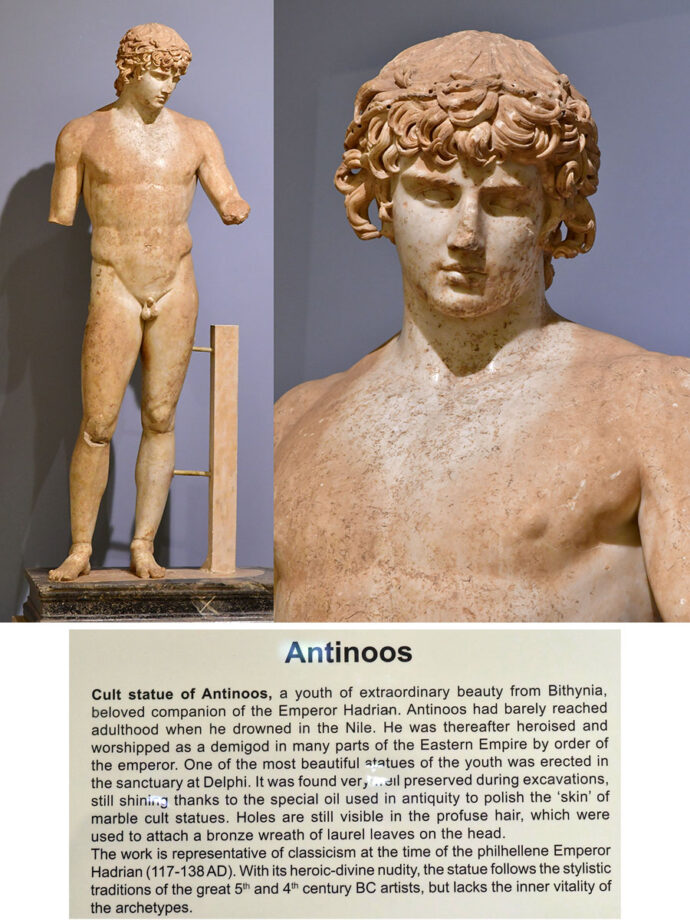
Antinoos was a very young and beautiful man who was a companion of Emperor Hadrian (117-138 AD). Antinoos had barely reached adulthood when he drowned in the Nile. The Emperor was devastated and ordered to make a lot of statues and monuments dedicated to the man for god-like worship, rituals, and admiration in his honor. One such sculpture was found in Delphi during the excavations. The statue was still shining because of oil used in antiquity to polish the skin. The holes in his hair served as attachments for a bronze laurel leaf wreath to crown the boy’s head. Both the presidents of the Pythian games and the priest placed this statue in the sanctuary. http://odysseus.culture.gr/h/4/eh430.jsp?obj_id=4672
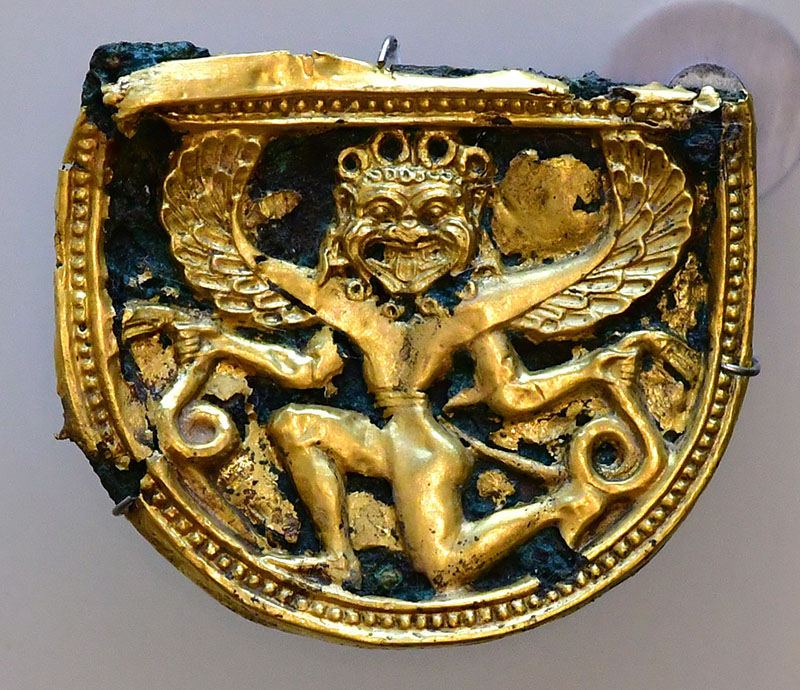
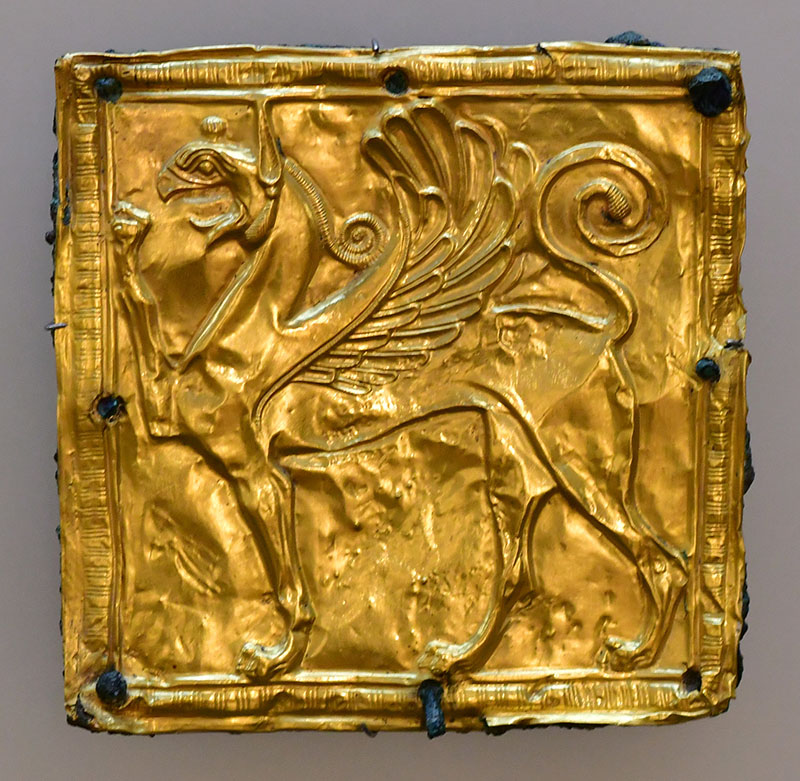
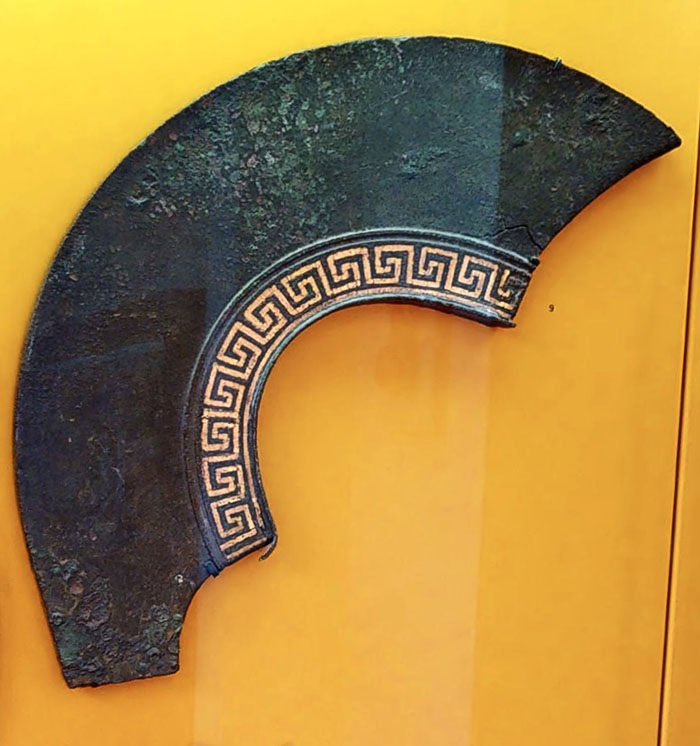

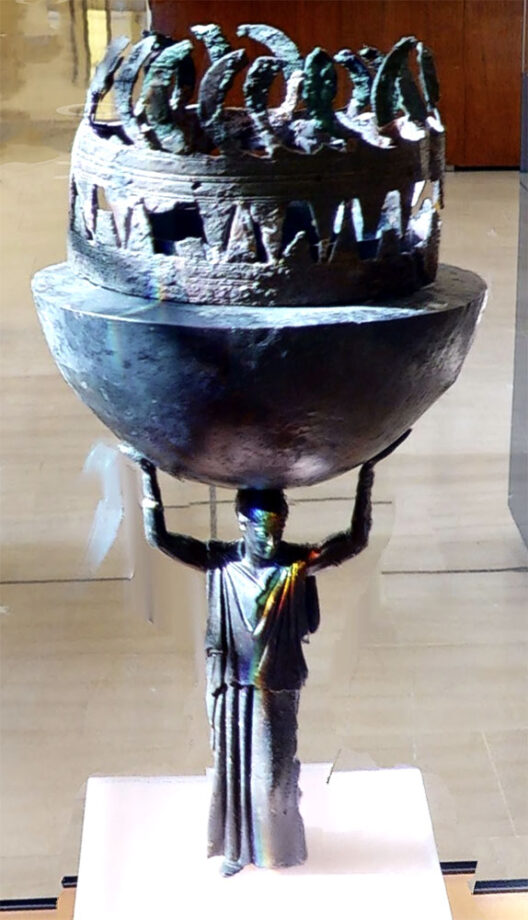
There are four monuments dated from classical antiquity: Lysander, Marathon, Argos and Tarantinians. Those were the monuments that pilgrims faced entering the temple of Apollo from the main entrance. A school and a small village occupied the site of the sanctuary after the 15th century AD.
The votive of Lysander or the Spartan Admirals’ votive
The Spartans created this votive in 404 B.C., dedicating it to their victory over the Athenians in the battle at Aegos Potamoi (405 B.C.). The recording of this monument exists thanks to Pausanias and Plutarch. According to the architect Didier Laroche’s study, the votive had the form of a rectangular pedestal with 39 bronze statues. The erection of the monument is connected with the rise of the hegemony of Sparta and the decadence of Athenian democracy. Facing the Sacred Way, the front side of this monument depicted Greek military figures and gods- Dioskouri, Zeus, Apollo, Artemis, Lysander (the winner of the battleship), Ermonas (the commander of the flagship), Agias, etc. The statues located on three other sides depicted the admirals of the allied fleet, who defeated the Athenians with Lysander.
The votive of Marathon
This monument was placed on the south side of the Lysander’s monument after the Marathon battle. The votive is dated around 490 B.C. According to Pausanias, one-tenth of the spoils of the battle were used for its construction. The 15m-long, rectangular pedestal held 13 bronze statues that included the sculptures of Athena, Apollo, the general Miltiades, and ten eponymous heroes, who according to the oracle of Delphi, gave their names to the Athenian tribes. The statues are attributed to the renowned sculptor of classical antiquity, Phidias. Three more statues of the Great Alexander’s successors were added during the Hellenistic period.
The Trojan horse
After their victory against the Spartans in 414 B.C., Argos dedicated a bronze simulacrum of the Trojan Horse to commemorate their prominent victory. According to Pausanias’s description, it was a work of Antiphanes from Argos. Today, only the stone plinths of the horse’s tiered pedestal and its fastening hole on the surface of one stone are preserved.
The votive of Tarantinias
The votive depicted bronze horses and women in captivity. Dedicated to Apollo, this votive comes from the residents of Tarans. They commemorated their victory over the Messapii at the beginning of the 5th century B.C. According to Pausanias, Ageladas, who descended from Argos, created this piece. In the partially preserved pedestal, the inscription states “Taραντίνοι Ἀπόλλωνι από Μεσσαπίων [ελόντε)ς δεκάταν” “The Tarantians dedicated this to Apollo from the tenth of the spoils they seized from the Messaplans”.